Weather in Summer
Hot, obviously, but we often get the tail end of cyclones around December or early January (on average there is at least one a year). However, these cyclonic influences often only really hit the east and the north. Sometimes we only get drizzle from them. January can be very hot and humid. February can be have prolonged periods of dry, but other years it can have useful rain and cloud cover. It is almost always hot and humid in February, and nights can be hot as well. Here on the Western hills north of Auckland we seem to experience hotter highs than Auckland City. Auckland's hottest air temperature ever was recorded at Whenuapai on February 12th 2009, hitting 32.4oC. On January 17th 2016 we recorded 32oC while the City recorded only 26oC.
2017 is shaping up to be 'warm'. The Met service said that January 2017 was the hottest month on record. Not just the hottest January, the hottest of any month, ever, since records began 150 years ago. It beat the record by a massive 3oC. The hottest temperature recorded for any part of New Zealand in January was 37oC, recorded in North Canterbury. On one day recently we hit 35oC in the shade. I would expect temperatures this high in mid February, not late January. The high temperatures are due to anticyclones blocking cooler air from the Antarctic, allowing the ocean to build up heat. A 'maritime heat wave'. Warm air holds more moisture, and when the summer cyclones drift down from the tropics, they can pack a lot of wet. Cyclone Fehi hit us on the 31st of January bringing a heavy dump of warm rain to the country, reaching the far south Island and washing out roads near Fox Glacier.
2018 was the hottest summer on record (by 0.3°C). The seas were warmer, up to 6°C above average, and we had the tail end of 2 tropical cyclones.
2019 started the year with classic hot summer weather here. The ocean surface is warmer by about a degree, but the weather is fairly typical - except we haven't had a tropical cyclone yet. December started hot early on, cooled somewhat.
2020 temperatures to mid January have yet to break past the high 20's. But at mid January has been very dry for weeks. Average rainfall for January + 1st week of February for Auckland is 79 mm. But this year Auckland had 7.8 mm, and we didn't get a downpour that hit the greater city area, so we have had even less, probably only a few millimeters from some brief drizzly showers. Hottest so far in the first week of February has been 32o C in the shade.
According to NIWA, Auckland had "the most consecutive days in drought or severe drought" since 2007 in 2020. The prior record (since 2007) was 65 days (in 2010), and before that 58 days, in 2013.
NIWA says "the drought was caused by several factors including persistent, blocking high pressure systems in the northern Tasman Sea and north of the North Island, suppressing rain-bearing weather systems to the south. There was also a lack of moist, northerly air flows and a persistently positive Southern Annular Mode early in the year which was associated with more tranquil weather in the New Zealand region."
NIWAS's projections for Auckland's future climate, based on their model for northern New Zealand, is for increased proneness to drought, a decrease in average rainfall (particularly in spring and summer), and increased temperatures. The result will be increased evapotranspiration from plants, and more call on soil moisture at the very time it is in least supply.
2022 the cyclonic Dec-Jan rains didn't come, at least where we are. A feature of late January, apart from unrelenting heat, was constant gusty winds. The soil became near bone dry by the beginning of February, but fortunately we had about 50mm of rain towards the end of the first week. This was enough to moisten the soil to about 30 cms, leaving the subsoil as dry as before.
December 1
Weather
2019 - Some much needed rain. Not much of it, 5-8mm, but desperately needed.
Nature
2019 - a fallow deer hind and its well grown fawn appeared in our tiny paddock by the veggie garden a few days ago. They both escaped into the adjacent native forest by squeezing under the anti-deer fence! Unusually, these were the common spotted fallow deer, not the black Spanish ones. Very pretty, can be a nuisance.
December 2
Weather
2017 - Cool at first, overcast, sunny spells, warm, a few showers. Cool in the evening. The grass is growing well, lots of black crickets about, it feels more like autumn, really.
2019 - Very hot - maxed at 28.9oC in the shade - humid, and breezy and drying in the afternoon. A little cloud. New growth on avocados is wilting in the heat.
Avocado
2012 - A Reed fruit fell off. I thought it was too early in the season, and would be immature, but it ripened up on the kitchen bench and was very good.
2017 - A very good crop on our big Hass tree. They are holding well, most are still green, a few have turned black on the tree, but not many. Very few fruit have set for next year.
2019 - quite a good set this year, conditions in late spring were ideal. Overnight temperatures have been very mild. We may see a fair set on the cold-sensitive Fuerte, for the first time in a long time.
Banana
2019 - a bunch of 'Goldfinger'is just starting to show color. Birds are already getting into them, so they must have split.
December 03
Weather
2014 - Hot, breezy, intermittently cloudy. Cicadas started mid morning, but gave up after a hour or so.
Nature
2014 - Going down the road early this morning I was startled to see two kaka's hanging upside down feeding on the nectar of the roadside flax plants outside this place.
2019 - Californian quail are 'paired up' and a constant sight, on rare occasions even appearing on the deck. There are heaps of blackbirds, thrushes, and various finches around as well. The grass is flowering and seeding well, so there is plenty for quail and finches to eat. Kaka are noticeable in the very early morning and in the evening - a squad of 5 flew over the other day.
Bananas
2014 - the 'goldfinger' tetraploid banana variety has finally started to color a few fruit on the bunch that has been hanging, full sized, all spring. I was under orders to collect it today, but the possums got to it in the night and wreaked substantial damage - even biting the ends off green fruit. Some eventually ripened, and I thought it good, but another whanau member just wasn't impressed.
Avocado
2014 - Reed has numerous small fruitlets, some Hass trees look to have a good set, the two little Gwen trees are hopeless and haven't set a thing, one little Maluma tree has apparently set hugely, and the others not a thing. Hashimoto is looking very promising, fruit set wise. The Pinkertons that cropped heavily appear to have set very few fruit. I counted 6 pea sized fruit on one tree, and about 18 on another, the other two in between.
Pine Nuts
2014 - Both Pinus maximartinezii and P. pinea have finished their male flowering. The exhausted male strobuli are drying up and falling apart.
December 4
Weather
2014 - Hot sunny, cloudy, cool northwesterly. The cicadas in the adjacent native forest are in full cry today, even 'tho the wind makes it feel a lot cooler than yesterday.
Nature
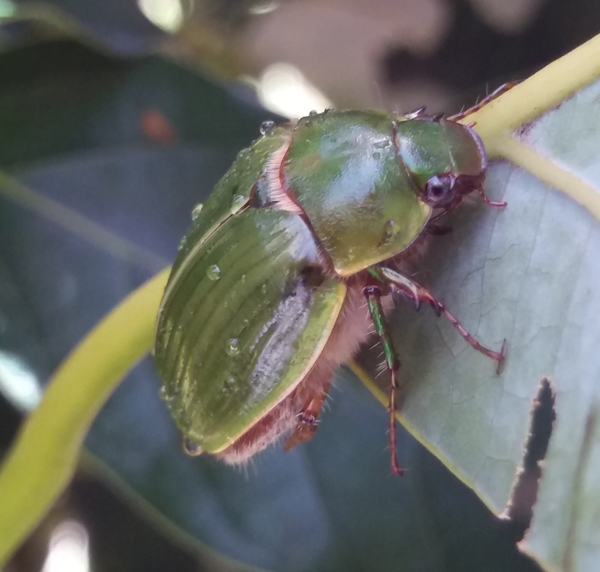 2018 - A large green cockchafer
munching on avocado foliage. Pretty, but not welcome. Three
beautiful big Spanish fallow deer hinds appeared in a paddock
a few days ago. We have plenty of grass, so in principle I
don't mind. But they snack on foliage, topping the male
flowers from our few pathetic little sweetcorn plants,
breaking plum foliage, and trampling on plants in the vege
garden - narrowly missing the newly planted basil! I managed
to trap them at the top of the little narrow paddock, but
before I could dispense justice they sprang over a 1.5 meter
fence from a standing start and bounded away. Pretty
impressive. They are large animals when you get up close, I
was quite surprised. The Woodhill pine forest wild deer (where
these probably come from) are the dark variant of the species,
and I suspect they may be a little larger than the much more
common farmed brown spotted type.
2018 - A large green cockchafer
munching on avocado foliage. Pretty, but not welcome. Three
beautiful big Spanish fallow deer hinds appeared in a paddock
a few days ago. We have plenty of grass, so in principle I
don't mind. But they snack on foliage, topping the male
flowers from our few pathetic little sweetcorn plants,
breaking plum foliage, and trampling on plants in the vege
garden - narrowly missing the newly planted basil! I managed
to trap them at the top of the little narrow paddock, but
before I could dispense justice they sprang over a 1.5 meter
fence from a standing start and bounded away. Pretty
impressive. They are large animals when you get up close, I
was quite surprised. The Woodhill pine forest wild deer (where
these probably come from) are the dark variant of the species,
and I suspect they may be a little larger than the much more
common farmed brown spotted type.Kaka have been around for months now, coming in to feed on the loquat trees (along with native pigeons and rosella, blackbirds, tuis...). The loquats are over now, so I guess they are just waiting for the first plums to ripen...
More welcome are the Californian Quail, which are now constantly around, mostly 'paired up'. I hope they have a good breeding season.
Plums
2009 - first Pixie plums are ripe - very early.
Avocado
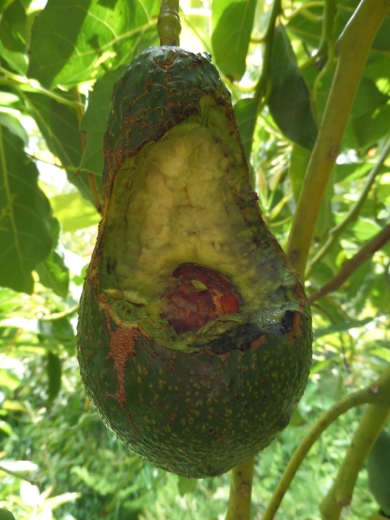
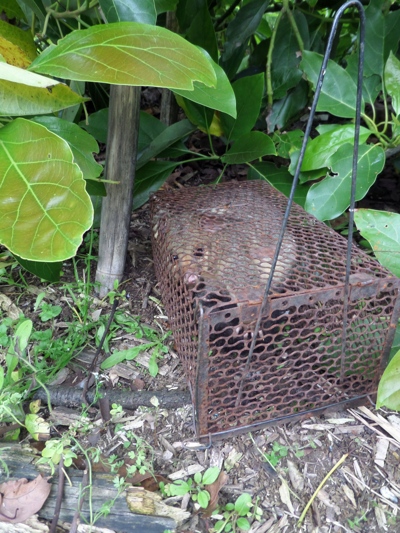 2014
- a Pinkerton avocado fruit was partly eaten on the tree last
night, and I wasn't sure if it was a rat or a possum, so I set
a rat trap and a possum trap under the tree. Next morning, I
found the rat trap had caught a young possum! I don't know
which of us was more surprised.
2014
- a Pinkerton avocado fruit was partly eaten on the tree last
night, and I wasn't sure if it was a rat or a possum, so I set
a rat trap and a possum trap under the tree. Next morning, I
found the rat trap had caught a young possum! I don't know
which of us was more surprised.December 6
Weather
2012 - Torrential rain, warm and humid. The temperature at 2.00pm is 20oC, the lowest overnight temperature has been 16oC. The highest air temperature in the last few days was 25oC.
Avocado
2012 - The new growth flushes are almost at full extension now. I am cutting out ultra vigorous 'watershoots', and trying to remove rampant growth without affecting the remnants of the flower panicles, some of which which may or may not have set a few fruit very late in the season.
The row of 4 Pinkerton trees have set 1 pea sized fruit each. There is one small ultra late sub-panicle of flowers open and in bud. The young Reed tree a few metres away is in flower, and although both are 'A' group flowers, I will be interested to see if any flowers set. Temperatures are certainly high enough.
December 8
Weather
2012 - after a very cold night, the weather is warm but windy. A few cicadas burst briefly into song, and many pokutakawas are well into flowering.
Plums
2009 - first Wrights Early are ripe.
2012 - the very first Wright's Early plum is about ripe.
December 10
Weather
2013 - hot and warm, we have had good gentle rain over a period of days, and the soil is fully re-charged and moist. Growing conditions are ideal, and the bamboo shelter has coloured up and started to extend new growth. The grass is starting to grow again, and the sheep are doing well.
Plums
2005 - Pixie plums have the first odd fruit ripe.
2013 - Pixie plums are coloring up, but nothing is ripe yet.
Berries
2009 - first wineberries are ripe - about 2 weeks early!
2013 - all the berries are producing very well (the wineberries are yet to start). The boysenberries are producing, the earliest we have ever had them, according to the berriologist.
Pomegranate
2013 - There are 10 or so flowers open, and more buds to come. The biggest flowering ever. Only the first flowers to open are likely to ripen a fruit, I would guess.
Kiwifruit
2013 - The green Skelton variety has well and truly set, and has a good crop, as it always has. The Hayward has just finished setting fruit, and it has a small crop, but better than last year.
We received a flyer from AsureQuality today telling us a representative visited our property "as part of a survey on behalf of ZESPRI International and the Ministry for Primary Industries". According to the form letter, the survey "is part of an international breeding programme which requires an extensive search for any kiwifruit plants in this area to identify an area free from the much publicised Psa-V disease." It then went on "We did not undertake a thorough search of your property due to your absence..." A search of our property??!!! Whaaat!!!?!???
Psa (Pseudomonas syringae pv actinidiae ) was found a few weeks ago in a commercial kiwifruit orchard in Kumeu. A 'control zone' with a 10 kilometer radius has been set up, wherein any duly appointed officer under the Biosecurity Act can enter and search properties for this unwanted organism. Fine. But we are well outside the control zone....so what the hell is someone with no statutory authority doing attempting "a thorough search" of our property? Especially when Psa " is also believed to be spread by footwear, vehicles and orchard tools, animals and humans." according to an MPI information page (http://www.biosecurity.govt.nz/pests/kiwifruit-vine-disease).
A phone call to AsureQuality Ltd. in Mt. Maunganui established that in fact there was no statutory authority, that the survey was unrelated to the Psa outbreak in Kumeu, and it was a commercial operation to try to find a Psa-free kiwifruit orchard that could grow budwood of new kiwifruit varieties to export to ZESPRI Ltd's partners in Europe! Apparently, European Ministries of Agriculture require a documented official assurance from MPI that the wood comes from an area of at least 4 kilometres radius officially found to be free of Psa. Such an assurance can only be given if a properly conducted survey is done.
Given Psa has been found in Kumeu, roughly 20km as the bird flies, and given "The disease can be spread via windborne pollen, strong winds and ....also believed to be spread by....animals..." (MPI site), then Psa turning up here is always a possibility. I decided to allow the inspection subject to the most strict precautions. The inspector duly turned up, parked outside the property, put on pre-bacteriocide treated disposable paper overalls covering the total body except for the face, donned disposable footwear covers, and put on disposable gloves. The check of the kiwifruit plants revealed no symptoms of Psa, and a further check is planned for autumn. All protective clothing, gloves, foot covers etc was removed on the roadside and secured in a plastic rubbish bag. The biosecurity precautions seem to me to be 'spot on', and I am confident the inspector is very unlikely to be a vector of the disease. Which turned out to be a good thing, as it turns out the inspector was in a Psa infected orchard the week before...!!!
When he left, I continued pruning the kiwifruit, and as the foliage piled up on the ground, I reflected on the poor bastards who have Psa infected orchards, and have seen the value of their property and business flushed down the toilet...beats me why anyone would be a commercial grower. Often-times price takers, screwed by the supermarkets, and even before you get to market, screwed by pests and diseases...
December 11
Weather
2012 - The weather has been sunny and hot over the last few days. The maximum reached 32.5oC in the shade. The lowest overnight temperature was 16oC.
December 12
Weather
2016 - After days of variable overcast muggy weather with odd light showers, it is now sunny and windy. A cicada sang, and it almost feels like summer. At last.
2018 - Hot, muggy. At 1200 it was 26o C. Later in the afternoon it hit 30o C. In the shade.
Black Sapote
2016 - Fruit are ripe on the tree. The biggest they have ever been. Flower buds are also just starting to appear. The flesh of the ripe fruit are very smooth, unctuous, sweet, with a faint persimmon taste. There is no astringency. There is no 'chocolate' flavor. The seeds are small - probably only partly formed.
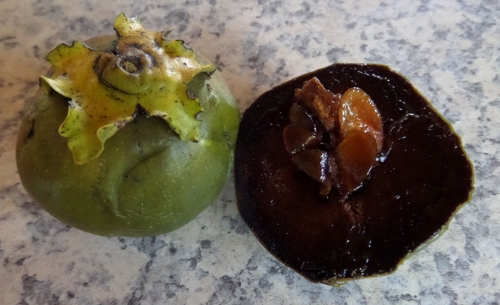
Soft ripe fruit (left), cut fruit showing the rich chocolate colored flesh.
Plums
2007 - the first Wrights Early plums are ripe.
2016 - Native fruit pigeons have eaten almost all young fruit of the Wright's Early. They also feast on flowers and plum leaves. We harvested 1 fruit. Very nice, well worth having. Santa Rosa plums are ripening, and, unlike the Wright's Early, there is a modest smattering left by the pigeons. When fully ripe, they have a perfumed very pleasant flavor.
Apricots
2009 - first Santa Rosa seedling (Waitakere) apricot is ready - around 2 weeks early
December 13
Weather
2013 - Summer has hit with a vengeance. Clear skies and sunshine for days. Today it is oppressively humid and very hot. At 6 pm it was 22oC. At the hottest point of the day it reached 32oC in the shade. Thunder had been rumbling out at sea, but the skies remained clear and no rain fell here. But a torrential thunderstorm pounded Helensville township for about 15 minutes late in the day. We had "about 5 drops of rain" according to the whanau. Apparently the thunder that boomed and rolled through the valleys was so loud that the local cock pheasant population rocketed into the air in terror, giving their alarm call.
2017 - After an insanely wet winter and spring, the rain switched off in November. Since then it has been hot and dry, with several days reaching just over 30oC in the shade!
2018 - Warm, muggy, overcast, a high today of 33oC in the shade. Thunderstorms predicted for tomorrow.
December 14
Weather
2013 - according to today's Herald, it was 27oC in Auckland.
2018 - muggy, warm, sultry, thunder in the afternoon and brief light rain.
Nature
2018 - Kanuka is now covered in its white flowers. Birds are nesting everywhere - sparrows, starlings, blackbirds. The male blackbirds mark their territories with evening songs of liquid beauty. Kaka and Rosellas are eating the first ripening plums.
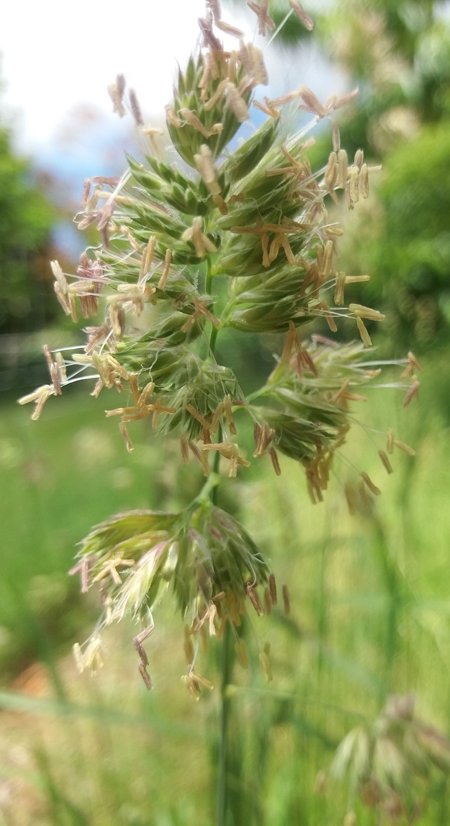 Summer time is also grass
flowering time. We have so much grass we are leaving some
areas ungrazed so they re-seed naturally. Perennial ryegrass (Lolium
perenne) is flowering right now. By the 20th day after
pollination the glumes enclosing the seed start to turn brown.
The seed reaches its maximum weight about 28 days from
flowering - but even at 14 days after pollination, the seed
germinates well, even although it has not reached full weight.
Summer time is also grass
flowering time. We have so much grass we are leaving some
areas ungrazed so they re-seed naturally. Perennial ryegrass (Lolium
perenne) is flowering right now. By the 20th day after
pollination the glumes enclosing the seed start to turn brown.
The seed reaches its maximum weight about 28 days from
flowering - but even at 14 days after pollination, the seed
germinates well, even although it has not reached full weight.
(Left) Cocksfoot (Dactylis glomerata), a distinctive, relatively tall grass, is also flowering well - producing copious pollen. It tolerates dry conditions in summer better than ryegrass, but can't be grazed as hard as ryegrass and the finer grasses, or it will die out.
Yorkshire fog (Holcus lanatus)is also heading up, and will soon be releasing pollen.
Figs
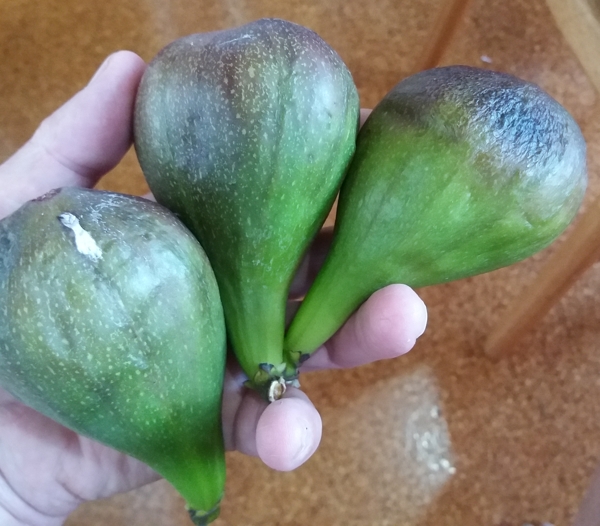 Some bird or birds -
probably Mynas and/or blackbirds - are eating the huge
'Petravicha' breba figs. They are almost ripe, but not quite.
The figologist picked some of them anyway, to "save them from
the birds". She has started putting home-made frost-clothe
bags on some of the others. A nuisance, but worth it for the
first figs of the season.
Some bird or birds -
probably Mynas and/or blackbirds - are eating the huge
'Petravicha' breba figs. They are almost ripe, but not quite.
The figologist picked some of them anyway, to "save them from
the birds". She has started putting home-made frost-clothe
bags on some of the others. A nuisance, but worth it for the
first figs of the season.December 15
Weather
2012 - The last week or so has been quite hot. Earlier in the week the temperature maximum was 25oC. Today it was 29oC. Night temperatures have not fallen below 12oC.
Plums
2012 - The first Wrights Early are ripening well now. They lack sweetness (the tree is shaded by a shelterbelt, but are OK. Billingtons Early is colouring well.
Apricots
2012 - the Santa Rosa flowered well, but only set half a dozen or so fruit, the first of which we found on the ground today. It had a bird peck, so we assume it was given an 'early exit'. It was fully coloured, the flesh had good colour, but it was almost crisp rather than soft and pasty, and it was acid and without any sugar whatsoever.
Boysenberries
2012 - first now ripe, a bit medicinal. Hard to tell when they are ripe
Blueberries
2012 - species blueberries are ripe.I think these are "Hortblue Onyx, aka onyx aka smoothie(Vaccinium simulatum). Berriologist picked a large yoghurt pot full.
Avocado
2012 - Hass - it is now obvious that only one tree has set any fruit at all, and even then only at the top of the tree. An avocado orchardist further down the road reports that their trees have also only set fruit on the tops. He has bee hives in his orchard, so there was no lack of pollinating insects. To add to the puzzle, some fruit have set low on the Hass tree, but on a branch that has been grafted to a different variety. The Hass flowers directly touching the branch didn't set - and I observed pollinating insects on both the in-graft flowers and the adjacent Hass flowers!
The only theory that we could come up with was that the weather was too cold for fruit set, and that as the top flowers are a little later to bloom, they just escaped the cold and thus set.
Reed - Our young Reed tree, now around 3 metres high, is at the tail end of flowering. It appears to have set a very large crop of fruit. The fruitlets are a bit bigger than a pin-head. Going on past experience, I would expect most of them to drop off. Hopefully some hang on and give us some fruit.
2013 - the young Reed tree has matured about 10 or so fruit, and most have already fallen. The fruit were rather on the small side, but the trees are unirrigated, so maybe that's why. A large number of fruitlets have set. Fruitlet drop has been under way for while, but its not yet clear how many will ultimately hold and swell. The small old Reed tree has a similar number of fruit, but has not dropped any yet. It, too, has a huge set of fruitlets.
The Hass fruit set, such as it is, is swelling well. There is quite a range in size of developing fruit, so set has clearly been over quite a period of time.
Cherimoya
2012 - Bronceada trees are finished, as is the Burtons Favourite. Some self-sown Burtons Favorite seedlings still have the odd fruit available to pick, but most are fairly pleasantly sweet, but without the acid note, the slight bitterness, and the complexity of flavor of a good cherimoya. One seedling is very nice, but it has finished fruiitng. Many of the trees have dropped their leaves, and are now re-leafing out and flowering.
December 16
2013 - Hot and relatively still. The high was 32.5oC.
Berries
2013 - this has been the best year ever for berry quality. The boysenberries are fat, turgid with juice, and free of 'dryberry' damage. They are still a fairly acid and slightly bitter number, but they sure pack the flavour and color. Likely they are very good for you. Success this year has been attributed to a combination of lack of rain during flowering (avoiding the fungal diseases that later destroy parts of the fruit), mulching, and significantly less damage from bronze beetles (attributed to the work of the little hens that have been in the berry cage over winter and spring). Sheep poo may have helped, as well.
December 17
Weather
2013 - warm and windy today, with the briefest of showers in mid afternoon. The high was 25.5oC.
2018 - Hot. It reached 30oC in the shade.
Nature
2013 - a bumper year for birds. Sparrows and blackbirds are nesting everywhere. The annoyingly relentless peep of the shining cuckoo chick is heard most days.
Plums
2009 - first plumcots are ripe (2 weeks early), and Wrights Early are now effectively over.
2013 - the first few Pixie plums are now ripe. Wright's Early has also started.
2017 - first plumcots are ripe (2 weeks early), and the first Wrights Early are now ripe. The plum and plumcot set this year is extremely heavy, Black Prince has branches so heavy with green fruit they droop to the ground.
2018 - plumcots are a wee way off from being ripe, but midnight raiders are eating them green. We strongly suspect Kaka, the silent night-time feeders. The Spring Satin crop - a whole 2 fruit - have changed color and look ready. We picked them today, before they are eaten by our 'friendly neighborhood parrots'.
Apricots
2017 - the seedling apricot is now ripening it's first fruit - 2 weeks early.
December 20th
Weather
2011- Its been windy, showery and rainy for weeks. Mostly from a warm quarter, but there has been one genuinely cold southerly day.
Plums
2011 - The wind has blown quite a lot of the stone fruit off, and we seem to have a plague of blackbirds, waxeyes and the odd kaka damaging and knocking off the early 'Pixie' plum fruit before they are properly ripe.
December 21
Plumcot
2011- One 'Spring Satin' plumcot has fallen off, and the rest look pretty ripe. We tried the fruit, and it was sweet and very good. The taste was a bit different from our other 'Heritage' plumcot - similar, but not the same. The flesh color was a winey pink, with a goldish tinge through it. The skin is apparently smooth, but actually has a just-perceptible 'fuzz' to it, a bit like an apricot.
This is now the earliest ripening stone-fruit on the property.
December 22
Weather
2012 - Ennervatingly hot and humid, almost without a breathe of wind, the temperature in the shade at 1200 is 26oC. The skies are alternately sunny and covered in dark clouds. The forecast is for rain starting tomorrow and continuing for 3 days.
Plums
2012 - The Wrights Early are ripening at a great rate now, and are much better tasting. Usually they would be 'done and dusted' by about the 30th of january. Billingtons early are still 'acid as'.
Apricots
2012 - the Santa Rosa fruit have had to be picked under-ripe to prevent further bird damage. We have a seedling here (probably a Santa Rosa seedling) that has a good crop on, and the fruit are a little behind Santa Rosa. They are usually ripe just after Xmas, but bird pecks are staring to appear.The fruit are better than bought ones right now, even if they are rather acid. They crack badly on top, so when the rain comes, they will split. Besides, the birds are just starting to put holes in them. We have picked the ripest, just in case. As the apricologist says, "it's a bit of a balancing act. Pick them too early and they don't ripen, leave them and the birds get them. I would rather pick them under-ripe and use them for jam than have the birds get them."
Boysenberries
2012 - Ripe, but very hard to pick when they are perfect. The berriologist says there is quite a lot of dry berry, and they would be best grown in a less humid climate (or sprayed - but who can be bothered?).
Wineberries
2012 - first few fruit are ripe.
December 23
Weather
2017 - Hot, some cloud a little wind. The weather has been very, very, hot and dry ever since late November. We have had the odd shower, nothing of substance. We desperately need rain. The pond is now very low, nearly as low as I have seen it.
Berries
2006 - wineberries starting.
Avocados
2017 - a bumper crop on the avocados this year. Heavy mulching and feeding has paid off. Improbably large numbers of new fruit have set on the Reed and the Hellen. I expect most to drop off. Some Hass fruit are starting to ripen on the trees.
Figs
2017 - a breba 'Petravicha' fig ripened today. It was eneormous, and I mean ENORMOUS! It had split open, but as it is so hot and dry, it hadn't rotted. And because the figologist had put a paper bag over it, the birds and insects hadn't been able to get it. The first fig of the season. It was excellent. The rest of the figs (the main crop) are a long way off. (The breba crop of 'Madelaine' would also usually start now, but the Madelaine is so shaded no breba crops set this year.
December 25
Plums
2011 - The first 'Pixie' plums are ripe enough to eat. They are a mid red, with a light bloom on the skin. The flesh is moderately red, and the small seed is a clingstone. While they are moderately sweet, they have quite a bit of acidity, and the flesh immediately around the seed is quite acid.
Brambles
2011 - It has been a bumper year for the berryfruit, with boysenberries in particular cropping like crazy. These fruit are large and juicy, but no matter how soft, I find then often a bit acid, and with a hint of bitterness. Probably very good for you. To be fair, they are large, hugely productive, have plenty of intensely red-purple juice, and are easily crushed into ice-cream or yoghurt, when they cut the over-sweetness of these products nicely. They have to be picked as darkly ripe as possible, which is nis easy to distinguish from the 'nearly ripe' condition. Having the sun behind you when picking them makes it easier to accurately judge. The Aurora berries are shiny and black when ripe; taste-wise, they are often very 'perfumed', but can also be a bit acid.
Cherries
2011 - The cherries have disappeared from the tree...
December 26
Weather
2012 - some light rain overnight, then totally overcast, with periods of light showers and a few brief rain showers. Warm, around 26oC. The last few days Tropical cyclone Evan was downgraded to a storm by the time it reached NZ, and the greatly anticipated rain only affected Northland. This part of West Auckland had only drizzle, total cloud and heat.
Figs
2012 - The figologist picked the first breba figs of Petrovicha, Brown Turkey, and an unknown cultivar ('tree #4"). Birds have eaten most of the Petrovicha brebas have been almost entirely eaten by the birds, so the figs were picked before they are as ripe as they should be. Petrovicha was OK, Brown Turkey had a lot of flavor but no sweetness, and number 4 was sufficiently sweet and had good flavor.
Boysenberries
2012 - Boysenberries are in full production. The berriologist says that lots of the berries now have little creamy opaque caterpillars in them. Around 50% of the fruit are affected to a greater or less degree of dried up druplets in the berry. Most have to be thrown out. Boysenberries have a wonderfully strong flavor, but it is very hard to pick the point when they are relatively sweet and not acid or over-mature and soggy and sour or rotten tasting.
Wineberries
2012 - A smattering of wineberries are ripe.
Plums
2012 - Wrights Favorite has very large numbers of fruit dead ripe. They are quite good, but last nights light rain was enough for every single dead ripe (deep purple-red) fruit to split its skin. The plumologist bottled some this morning, and chucked the rest out.
The Billingtons Early (which we suspect may be Billington), is still not fully mature, albeit you could eat the reddest ones if you had to.
The first Santa Rosa is ripe. This is "quite early" for this variety here (according to the plumologist), although it seems to vary by a week or two every year.
The first Pixie plums are ripe and falling from the trees.
Apricots
2012 - This years crop has turned out to be the biggest and best we have had in at least 20 years - and all from one tree, a seedling we bought from a guy in Waitakere many years ago. The fruit incredibly, have not split or rotted in spite of the showers and constantly humid conditions. The fruit are small, yellow-orange blushed with pinky red, and they are sugar sweet, and with a nice acid bite. A year to remember. Birds damage is minimal so far, and the few somewhat immature or badly damaged fruit have been turned into jam.
Avocado
2012 - one of our two smaller Hass trees with a good crop of early maturing fruit has dropped several green but mature fruit overnight. The few remaining fruit have sized up markedly in the last week. There are no fruit set for next year on this tree (albeit there is bound to be the odd one that I can't spot).
The intermediate age Hass tree is holding a good crop of mature green fruit, some of which are a very good size, but no fruit have fallen yet. It has set and held a useful number of small 'next season fruit' high on the tree.
The other of our two smaller Hass trees has only a few current season fruit on it, and late sets at that, so they are small relative to the others. This tree flowered very heavily, and had some 'match-head size' fruitlet set, but has not held anything for next year.
Our 'old' Hass tree has quite a good crop of fairly small fruit, some of which are starting to color on the tree. I expect they will start dropping soon. It had a very sparse flowering this spring just gone, and there is zero set for next year.
Our seedling Hass tree which had a massive number on match-head and small pea sized fruit set has dropped almost all of them. There are two marble sized set fruit visible from the main flowering, and a smattering of late set flowers of match-head size. Whether they hold remains to be seen.
The 'old' young Reed tree has 3 or 4 'large marble' sized fruit set from the main flowering, and a good number of match-head size fruitlets set from the late stage of flowering.The young tree had a massive number of match-head size fruitlets apparently set from the main flowering, but dropped all bar 2 or so fruitlets, which are now marble sized. There are a useful number of late set flowers that have apparently set and formed match-head size fruitlets. Whether any will hold remains to be seen.
The few marble sized fruit on the Pinkerton earlier in the month have fallen off.
It is clear that we will have very few avocado fruits next year.
December 27
Plumcots
2011 - The heritage 'Kerby' plumcots we have here are just starting to ripen. They are about 2 weeks later than normal, don't know why.
These very attractive light red and gold skinned fruit have soft, juicy flesh, and are freestone. They are sweet, quite without acidity, and with a hard to describe flavor - maybe a hint of fingernail polish (amyl acetate, similar to the flavor of a very good musk melon/cantaloupe). They are very 'moreish'.
The possums think so, too.,,
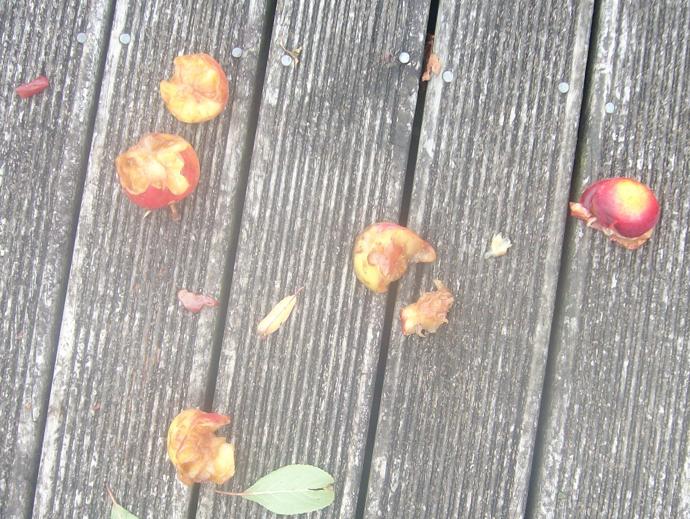
December 29
Apricot
2007 - Newcastle fruit now ripe.
2025 - Our 2 (only) Fitzroy fruit picked a couple of dayas a go are now ripe. Very good sugar to acid balance and very good flavor.
Cherries
2012 - we harvested 3 perfectly ripe deep red-purple from our netted cherry tree, which is, from memory, Lapin. They were intensely flavorful, sweet and crisp. All the new foliage is heavily damaged by aphids, but who cares (who would spray a tree just for the sake of 3 cherries?).
Plums
2025 - some Santa Rosa fruit are coloring, but aren't yet ripe. Wrights Early are over. The fruit pigeons absolutely smash Wrights Eary and Pixie leaf and flower buds, so the crops on these two are now fairly thin. The first Pixies are now ripe.
Plumcots
2025 - Kerby plumcots are starting to pump. As usual they have a heavy crop - barring one isolated tree which is for some reason loved by the fruit pigeons. The Spring Satin has had 18 fruit, which is the best ever. I wasn't impressed by SS in the past, but if they are left to tree ripen (bagged against the birds) and then left for a few days on the kitchen bench they are very nice - enough acid, good sweetness.
Blueberries
2025 - suddenly, they are ripening up. They are really reliable and productive. Even small plants only in the ground a year can have really good crops. The bushes are generally small enough to net against birds, and excess fruit can be frozen and used later in yoghurt or muesli.
December 31
Plumcot
2005 - the first plumcots are now ripe.
2012 - the plumcots are producing heavily. They litter the deck.
Plums
2005 - Pixie starting.
Apricot
2007 - Waitakere seedling (Santa Rosa seedling) starting.
January 1
Weather
2012 - It has been raining on and off for days.
2013 - sunny and hot. It was 25oC air temperature at noon. The weather over the last 8 days or so has been a mix of cloudy, drizzly, some rain, still and clear, blue skies and sun. One day was very hot, hitting a staggering 30oC air temperature!
2014 - overcast, a little rain, drizzly. Northerlies, with a possibility of isolated thunderstorms later this afternoon. Relatively warm. The last 2 weeks were not as hot as the beginning of december. There was one hot day about the 19th, but for the rest it has been warm and pleasant, interspersed with overcast days, some showers, and one day with enough rain to re-wet the soil. We have just 'scraped by' soil-moisture-wise. It would have been better to have more, but we did get 'just enough'.
Berries
2012 -The berries continue to pump out without the expected fungus, much to my surprise.
Raspberries
2012 -The stars, taste-wise, as always, are the raspberries, which have amazing and unique intense fragrance, sweetness and 'just right' acidity balance.
2013 - raspberries are still going well, especially the 'black' raspberries (which are dark purple, really). There is now a genuinely black raspberry on the market, a variety called 'ebony'. Black, alright, dark purple, raspberries have a slightly more muted flavor compared to the red. But the flavor is nevertheless intense.
Loganberries
2012 - Second best berryfruit are the loganberries, which are like a longer and oversized raspberry. They have the raspberry flavor, but with more acidity.
Boysenberry
2013 - these very vigorous berries are producing well, in spite of the 'dryberry'. The berriologist is fed up wih them, because they are so vigorous they block the path,the dry-berry mean sa lot are wasted, and they are very hard to get exactly ripe, not under and not over. She says she will eliminate them entirely, and put strawberries in their place. Fair enough. They are quite good, but I find them often a bit acid.
2014 - boysenberries are now slowing right down. Wineberries have started, and while the ordinary raspberries are effectively finished (they will have another small crop crop later), the 'black' (dark red, really) are just getting under way. These late raspberries are inferior in flavor, but still very nice.
Plums
2012 - The Pixie plums are now fully ripe. They are a dark, dull wine red, covered in a whitish bloom. The flesh is still firm, crunching slightly as you bite into it. It bears, according to the chief fruit picker "just insane" amounts of fruit. The tree has been visited almost every night by one or more possums, and half eaten fruit litter the ground. The chooks are sick of them. The plum-picker dutifully and resignedly reminds me - as she does every year at this time - that I had promised to build a pigsty and buy a weaner to fatten on windfall and damaged summer fruit...oh well, next year!
2013 - lots of Pixies ripe. The trees have a heavy crop. The fruit litter the ground, and we leave them for the sheep (we decided the maths of feeding a pig, plus the time cost of humans picking up the windfalls, didn't stack up). The plumologist cut some into pieces and sun dried them down to thin red chewy acidy things. Quite nice. The flesh is creamy yellow in the ripe fruit, so I was surprised they dried to a predominantly red color (due to the skin).
Wrights Early is finished, and Santa Rosa plums are ripening well now. The Billingtons (a small red fleshed plum,,deep red/purple and with a with a heavy boom when fully ripe. It is similar in appearance to Pixie, but Pixie is a little larger, deeper purple when fully ripe, and with a heavier bloom. Billington may have a marginally better flavor.
2013 - our yellow skinned and flesh plum with soft juicy flesh is ripe. Moderately sweet, no real flavor, forgettable.
2014 - the birds have eaten everything. Only one or two Billingtons have been left. The quite nice late yellow plum are being eaten. We could pick them early, but they are not really worth eating unless fully tree ripened. A state the birds will never allow. The plumcot crop has been poor this year (they were pruned very heavily last year), and the birds have got most all of them. We picked the ripest Santa Rosa fruit to beat the birds, so they got into the half ripe fruit instead. So we had to pick the remaining half ripe fruit, too.
These frustrations with bird damage lead to a conversation with the chief plumologist on how many plum trees we really need versus having a wide variety, the size of the trees, dwarfing rootstocks, pasture management, using sheep versus mowing grass, and netting whole trees versus growing so many the birds can't eat them all. A lot of thought-provoking ideas. Maybe a major rethink of the most appropriate practice is needed...
Apricots
2013 -the last dozen or so fruit have been picked, not because they are fully tree mature, but to beat the birds. What a year it has been for this tree! We even dried some (as pieces, not halves, as they sun-dry quicker when cut smaller).
Avocado
2012 - The spring/summer flush on the avocados now have full sized leaves, but they are still soft and not fully mature. The older leaves behind the new flush have been dropping for several weeks now. The older leaves tend to drop at, or soon after, initial fruit set.
2013 - flush are nearly mature, and vigorous growers like Reed are maturing their soft 'watershoots', they axillary buds of which are now growing thin laterals. The ground is moist and the weather hot, so I had another go at grafting. The commercial folks graft in spring, I think, before flowering starts. But I think that is mainly grafting seedlings, and is probably done in a greenhouse. The scionwood is too soft and young at this time of year, and the new buds are not that mature. But I had a go anyway, as well as grafting some seedlings I have on hand. I tried side wedge grafting with small terminal pieces of soft wood (the only semi-decent wood I could find). It is tedious and hot work, and takes me hours. There has to be a better way.
The Reed still has some match-head sized fruit set, in addition to its 2 or 3 marble sized set fruit. Our Hass seedling has around 20 - 30 fruitlets of pea size. How many will remain is a moot point.
2014 - new growth flushes are tearing away on the young trees that are yet to fruit. Older trees are having a further modest leaf drop and small flush.
Figs
2013 - the figologist brought in half a dozen massive Brown Turkey breba fruit. She picked them to stop the birds from getting them. They are fully sized, but not tree mature. Once ripe, I am willing to bet they will be OK, but lacking sugars. We'll see.
2014- the few breba figs we had this year got eaten by birds...
Longan
2014 - one of our 2 longan seedling trees had a couple of flower panicles last year. Nothing set, maybe because the bronze beetles damaged the panicles severely. This year, it has a few flowering panicles again - about 3 weeks earlier than last year. The other seedling also has a few flower panicles - the first ever for the tree, after around 20 -30 years in the ground. There is bronze beetle damage, but not as much as last year. Maybe a fruit or two will set. Even if it did, because these are seedlings, the fruit are likely to be inferior to imported fruit.
Cherimoya
2014 - leaf drop is almost complete on most trees. They are now flowering heavily. Mummified fruit destroyed by the black rot fungus litter the ground. A whanau member has chainsaw pruned the trees very severely in an effort to improve airflow and reduce disease incidence.
Sheep
2014 - the sheep are in pretty good condition, but the same can't be said for the pasture. It has been 'holding its own', but the driest faces have deteriorated and become full of Acaena ('bidi bidi'),
January 4
Weather
2014 - sunny and windy this morning. It is hot and humid. At 10:00 (real time) it is 27oC.
January 9
Weather
2013 - sunny and a little windy this morning, but by midday there is only a light breeze and it is hot. It is 29oC at the moment.
Plums
2013 - The Pixie plums are very ripe now, and falling from the trees. Santa Rosa is in full flight. The ripest are very perfumed, hard to describe, sweet, very juicy, and then really quite acid at the skin, which takes the edge off the pleasant eating experience.
The yellow skinned and fleshed plum is now actually quite pleasant, although it has no acidity, only sweetness.
Plumcots continue to pump out absurd amounts of fruit. The most fully sun mature are very very nice, but other fruit are pretty mediocre. They are very soft at this stage.
Avocado
2013 - Our earliest to mature Hass tree has thrown off another 4 fruit, all a very good size. The old, small, Reed tree has probably a dozen fruit set, mostly small marble to marble size, plus a couple of very late set pea sized fruit. All the trees continue to drop old leaves and harden new flushes.
Bananas
2013 - There are now around 5 banana clumps hosting a bunch, from just set to several months old. The earliest set bunch should ripen about june, but the cold may stall it. The rest will likely be late winter to spring. Not the best time of year.
January 10
Weather
2018 - after huge amounts of rain December (2018), January has been dry and sunny so far. Yesterday the temperature in the shade hit 30oC, and today it is 29oC at midday.
Plums
2019 - All the plums are over now -about 2 weeks earlier than normal.
January 12
Weather
2011 - Rain and showers on and off, with the odd sunny break have continued (and look set to continue for some time yet).
Blueberries
2009 - Early small species blueberries have about finished.
2012 - The 'early' blueberries we have here are all but finished. Most are from garden centres around Auckland, and virtually the only blueberries you can get are those supplied by 'Incredible Edibles' Ltd, who have a licence to propagate blueberry varieties bred by HortResearch Ltd (the former government department 'DSIR' before it was made a State owned enterprise).
According to their website, these are .
We have Blue Dawn, whose real name is 'Takahe'. This is our biggest blueberry, but is still only around a metre high, and is pretty much an evergreen. It has had only a couple of ripe fruit so far this year. It is a ‘Rabbiteye Blueberry’, Vaccinium ashei. The 'rabbiteye' group don't need as much winter chilling to fruit as most others, and are said to be a bit more adaptable to soil type, not requiring as much acidity. We threw in a good amouint of peat when we planted them in out sandy clay-loam, and have subsequently mulched them with pine needles to keep the acidity levels up.
We had , but it has died. Whitu is also a rabbiteye type, and we planted it as a pollininizer for Takahe. Note to self: must buy another plant.
O'Neal is a variety in the 'Highbush' group, but from the Southern USA, meaning it requires less winter cold to fruit. It is a inter-species hybrid, incorporating the low chill Vaccinium darrowi with both Northern and Southern Highbush varietys (species and hybrids of mainly Vaccinium corymbosum with some V. angustifolia). We put this one in a few months ago, so there is no result as yet. It is supposed to start fruiting in late November, which would make it the earliest blueberry on this place.
But the earliest blueberries are our three 'Smoothie™' or, correctly, 'Onyx' cultivar blueberries, which are selected from an 'upland' highbush species from Southern USA, Vaccinium simulatum. These are dwarf blueberries selected more for their ornamental flowers more than their copious quantities of very small fruit. They are highly productive, but the dark blue fruit are pretty forgetable - slightly bitter, somewhat seedy - but still sufficiently juicy and pleasant enough.
Plumcot
2012 - The Kerby plumcots continue to ripen, in spite of the rain.
Plums
2012 - the first Santa Rosa plums have turned dull red. The possums continue to ignore our Timms traps...
Bananas
2012 - A bunch of bananas has ripened on a variety I have had for years, but which has not, until now, produced fruit. I bought the plant locally, from Nestlebrae Nurseries (now closed). It was sold to me as 'one of the better Ladies Finger types'. I previously didn't pay it much attention, as most of these 'Ladies Finger' bananas seem pretty similar to me, we already have several clumps of "Ladies Fingers', and Nestlebrae couldn't tell me the specific cultivar name anyway. But this one has turned out to be a cut above the rest, so far, at least. There were only a few fruit in the bunch that had split, and the fruit were sweet, dense fleshed, and had a nice flavor. Most importantly, there was no trace of astringency. The unopened flower bud appeared in April 2011, so this autumn flowering, winter/spring maturing fruit has taken 12 months from bud to harvest - in contrast to the summer flowering, autumn/winter maturing, October bunch.
January 14
Weather
2012 - totally overcast and grey, humid, breezy. Temperatures are moderate, 22oC. It hit 31oC in one of the last few days. It is dry.
Plums
2013 - the first Elephant Heart plums are fully colored and near ripe. The Black Prince are beginning to show color. The yellow plum, so insipid earlier in the season, are deeply colored and very ripe, and rather pleasant. Some Santa Rosa have ripened to to a deep purple-red, at which point they are even more bursting with juice than usual. Santa Rosa seems a particular favorite of the birds. They are still acid at the skin, but significantly less so. The plumcots are all but done, and the Pixie plums are also fading fast.
Avocado
20123- Trees are shedding leaves at an accelerated pace. Some are starting to flush again. The most advanced set Hass fruit are about small plum size. The fruit remaining on our middle sized tree are gaining a lot of size.
Figs
2013 - the figologist harvested a few more very large breba Brown Turkey as the birds have made their first tentative peck in them. They are not as fully tree ripe as they should be, but by tomorrow the birds would have hollowed them out. They will continue to ripen off the tree. This year, the Brown Turkey breba crop is extending into the very beginning of the main crop, which means Brown Turkey will just about crop continuously this season.
January 15
Weather
2014 - It has been very windy and overcast for days. But no rain. At least it was a bit cooler. There has been just enough odd shower in the last few weeks to keep the grass vaguely ticking over, but that's about it. Once again, we are thankful for kikuyu, which the sheep nibble close, forcing succulent new growth. Today is breezy, sunny, blue skies, and hot. It is 25oC at 1 pm.
Berries
2014 - every time the berriologist claims the 'black' raspberries are over, she seems to come in with another cupful. They are intensely flavorful, sharp, only a little sweetness, and full of juice. The boysenberries keep coming, and the wineberries are really pumping out.
Peaches
2014 - We don't have any peaches ripe yet, but either kaka or possums have started on the unripe fruit.
Avocados
2014 - fruit set on some trees is looking encouraging, but the jury still out as to how many will hang on through the increasing dry. Some young trees that flushed several times earlier in the season have now stopped flushing and fully expanded their leaves. Their leaves have now turned dark green, and the trees look well set up to photosynthesis over summer and pack on the reserves needed to flower well and set fruit in the end of year flower season. As long as we get some rain in the not too distant future....
January 16
Weather
2018 - windy, hot, sticky, overcast and sunny. It has been very hot and with no rain for weeks. Nights have been hot and sticky. Weather more typical of February. Luckily we had a cyclonic downpour just after New Year which saved us from deep drought despair. It has been hot and dry since, but rain is forecast for a little later in the week.
Avocado
2018 - Our large tree has a mega crop. We have been giving avos away to whanau, but we still have a large number on the tree, and they are starting to turn colour. We had a a very good crop on our two head-high Maluma trees. These are far better than Hass in the early part of the season, but at this time of year, while Maluma is oily and nice, it simply does not match Hass in flavor.
Plums
2018 - a mega plum year again, especially the Pixie plums and the Plumcots. Fallen plums litter the ground under the Pixie - far too many, even for the birds. They squash under jandalled foot, and you can slip if you are not careful. The Spring Satin only had a few fruit, as usual. Possibly it is too far from a pollenizer. A heavy flowering Kirby plumcot close by obviously is not suitable.
Pests
2018 - Passion vine hoppers (Scolypopa australis) are present in big numbers on some of the avocado trees, mainly on some young trees we have here. White avocado sap-sugars crystallize on the leaves below their activity. They focus on young growth, and particularly like the stems of small developing avocado fruit. They are becoming a bit of a menace. I could spray them, but I almost never use insecticides here, and besides, I can't be bothered...It puzzles me that birds don't eat them. Or if they do, I haven't noticed - and they don't eat enough! Apparently there are several tiny parasitic wasps that destroy passion vine hopper eggs, and they are fairly widespread. If they are on this property, I'd like them to work harder!
January 20
Weather
2020 - It has been hot and dry for weeks. Nights have been hot and muggy. More like February, really. No rain in sight, but at least it is forecast to be partly cloudy this week.
Nature
2020 - a few young quail spotted on the place, which is great to see. However, a marauding cat is also around. I caught it in the possum live trap -apparently it liked the avocado bait. It was a ball of fury, hissing and spitting and lashing out. However, I had to accept that it could be someones pet, with mixed feeling, I let it go.
Avocados
2020 - most are OK in the dry, but those with a touch of Phytopthora are dropping leaves. The water tanks are holding up well, but we can't afford to give anything but the most precious of trees any water, and then only a bucketful once a week (at best).
January 21
Weather
2012 - We have had spells of fine weather, bright sunshine even, amid the cloudy, showery days.
Nature
2012 -The garden is host to a fat shining cuckoo fledgling, whose incessant, high pitched squeaking to its grey warbler foster-mother for yet more food soon becomes tedious.
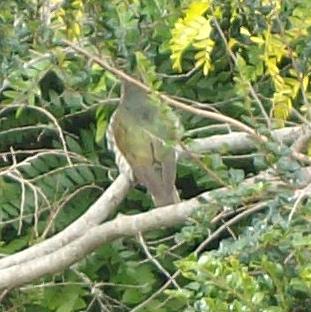
Berryfruit
2012 - The berryfruit have slowed down, especially the boysenberries. The few loganberries now ripen too quickly. They are firm and acid one day, but over-ripe the next. Raspberries remain the stars - even picked a bit underripe they are quite good. At the moment, there are a 'fair lot' of berries in the freezer, the providtrice has made several lots of jam, bottled boysenberries, and one whanua member has made made some experimental berry leather. Berry eating is a compulsory, not optional, activity...
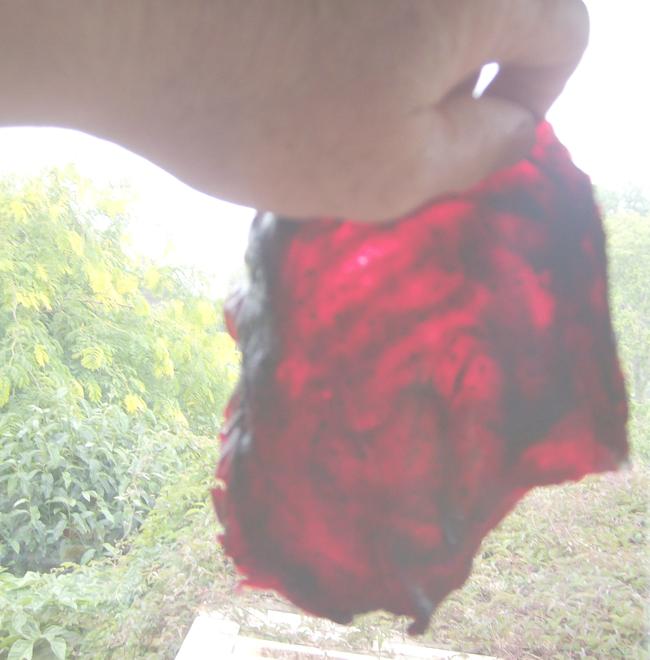
Plums
2012 -Early plums have gone, and Santa Rosa, the next cab off the rank, is also about finished. Santa Rosa plums are very juicy -dripping with juice in fact - and sweet, albeit a bit acid around the skin and the stone. They have a vinous, almost floral flavor, altho' several members of the whanau claim they taste 'chemically', and refuse to eat them.
Black Prince is the next (and for us, the last) plum to ripen, but it is a way off yet. The possums have been climbing in the little tree and knocked off a significant amount of the fruit while it is still green. They don't seem to eat the green plums - in contrast to the little green immature peaches by the house, which an possum was noisily munching on at 3.30 in the morning the other night...we continue to have no success killing the little bastards with Timms traps ( even though we have 3 set most of the time).
Avocado
2012 - The rain and warmth has meant that the avocados continue to flush. I had hoped the flushes would have matured by now, as I want to have another go at grafting while the weather is warm and the ground is not yet dry. Last year I put on around 15 or so grafts, but only 2 took.
January 22
Weather
2012 - Its been overcast and rainy all morning.
2013 - the last week has been cloudy, windy and somewhat cool, with temperatures of around 25oC. But the last few days have been hot and windy, with lots of bright sunshine.
Blueberries
2009 - main crop blueberries now starting
Bananas and Avocado
2012 - Our corn plants are looking somewhat yellow, clearly needing nitrogen. So its on with the raincoat and gumboots and off into the light rain with a bucket of urea granules. The bananas and avocados would benefit from some nitrogen as well. Spreading urea is always a gamble, and an expensive one (something like $4 a kilo bought in a 40 kg sack, from memory). So a bucket of urea, at roughly 6 kgs, might be worth nearly $25. If the soil isn't already damp and you don't get at least 5mm of rain soon after application, a significant part of the nitrogen will be released to the atmosphere, rather than to the soil. As soon as the urea was distributed, the rain slowed to a misty drizzle. I knew that the soil was starting to dry out underneath the trees, so I stood there in soggy shorts and wet gumboots, watering the urea in with the hose. Such is the fate of the home gardener.
In contrast, the commercial boys and girls don't have to worry, because they have irrigation to all their trees, and they run liquid fertiliser through the pipes at the same time. The soil is kept optimally moist, and the trees well fertilised with relatively little effort.
2013 -the ground is very dry indeed. We need rain, and persistent rain. The avocados have almost done their drop of last years leaves, and vigorous new shoots have either hardened up, or are hardening up. It's time to prune the avocados. One Hass tree has no fruit set, so has been pruned relatively close in to the trunk, and topped at about 2. 4 metres.The small crop set on another tree are about golfball size. This years mature crop is hanging well on out 2 producing trees, and some fruit is now quite large. Hopefully they will store on the tree until march/april (longer if I'm lucky).
Figs
2012 - The resident figologist harvested the remaining early 'breba' fig crop - all 4 fruit.
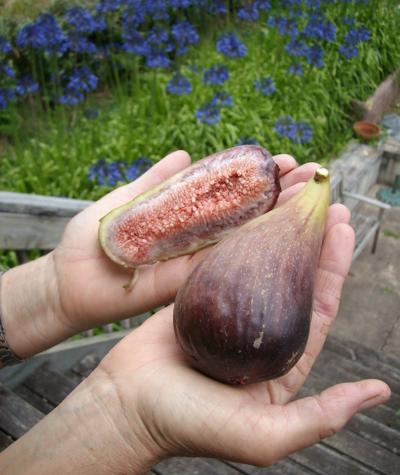
These are the 'Brown Turkey' variety of fig. The breba figs are large, but there are generally very few of them - and the birds love them. As it happens, the season has been so wet and 'sunshine deficient' that they are pretty tasteless - altho' the figologist claims they are still quite good. She tells me that the fig variety 'Madeline' has the largest breba crop - but only a handful matured in the last 2 years (although last year years fruit drop was likely caused by hormonal spray drift from neighbors, a recurring problem in most rural areas).
2013 - the figologist had to harvest the few remaining breba fruit early, as Kaka parrots have ruined the rest. The main crop figs are still yet to start.
Peach
2012 - The possums appear to have moved onto our white-fleshed peach tree (possibly 'wiggins'), just as they are about to ripen...
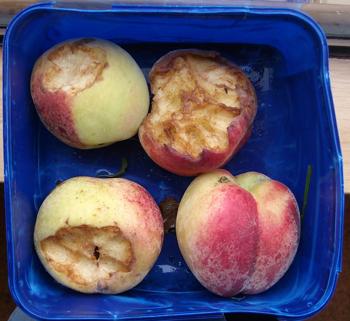
I've set 2 Timms kill traps under the tree, baited with fresh sweet carrot with a hint of cinnamon. Having ignored the Timms traps for weeks, I don't suppose they will now find them interesting. Still, y' gotta have a go.
2013 - the first white fleshed peach has fallen from the tree.
Plums
2013 - the few Elephant Heart fruit, much treasured by the plumologist, are now ripening. They ripen over quite a long time, but their crop is being cut short by Kaka, which take a little bit out of quite a number of fruit before settling down to have a good feed on one fruit. These birds are increasingly problematic.
The Black Prince are starting to color a little more, so they won't be very far off - as long as the Kaka don't destroy them.
January 23
Weather
2018 - We have had showers and some bursts of rain recently, all of it warm and 'tropical'. Today is overcast, sometimes sunny, sometimes with a welcome slow breeze. A few cicadas lazily drone into the humid air. It is unpleasantly muggy, quite impossible to be outside without soon being prickly with sweat.
Nature
2018 - A very decent group of adult and juvenile quail moved through the garden today. A joy to the spirit. Kaka are noisily present from early morning, either falling silent or disappearing in the heat of the day. A shining cuckoo calls. We now have four diamond doves frequenting the place. I enjoy their gentle but admittedly monotonous cooing. Other whanau members find it irritating, and refer to them in rather unkind terms.
Peaches
2018 - Our small heavy-bearing peach is ripening fruit - a bit earlier than usual. As if on cue, possums suddenly appear to eat them. No luck with the Timms trap as yet. Sigh. We don't spray the tree, and the humid heat is ideal for brown rot, which is spreading.
January 24
Weather
2012 - Another bright sunny day with a cool southerly, just like yesterday.
Nature
2012 - One of the side effects of having unmown pockets of trees fenced off from the sheep is that we have rank tall grass and weeds in these areas. While I more or less keep on top of the more objectionable weeds like thistles, anything else is left to grow, flower, seed and die. So we tend to have some good food sources for miscellaneous insects.
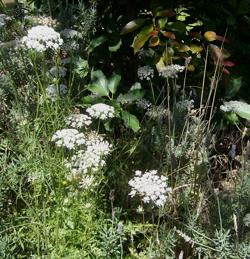
The Queen Annes lace is flowering at this time of year, and I really like the tall flowers, with their 'grapey' smelling, flat, creamy-white umbels. An odd, wedge-shaped insect also shares my appreciation.
Our copy of 'The Life-Size Guide to Insects', by Andrew Crowe, identifies it as the 'Large Pintail Beetle', Mordella antarctica. (There are actually 7 species of Pintail beetles in New Zealand,and all but one are natives.) If you get too close, they abruptly jump, or fall, off the flower. Apparently they are part of a group of beetles commonly referred to as 'Tumbling Flower Beetles'. A drawing on page 156 of a Landcare paper (.pdf) is here.
January 26
Weather
2014 - A low pressure system coming off the Tasman carried a lot of rain in its leading edge, giving us a sustained burst of heavy warm rain. The gutters were overflowing. We had about 20 mm or so, which will make a huge difference to the drying pasture.
2022 - We have had only about 5 mm in the last 30 days since Xmas. Using water is a constant worry. Weather systems coming down from north seem to swing east, and miss us. 30o C in the shade today, hot and extremely humid.
Hazels
2014 - the first few hazels have fallen. Although fully formed, almost all were empty.
Avocado
2022 - I gave the 2 years-in-the-ground avocado seedlings about 2 liters each 3 weeks or so ago. Today I am giving them another 2 liters each. It is enough to be getting by on. Some are dropping leaves, and the odd enthusiastic plant that put out lots of new growth in spite of the dry is now paying the price. But the plants seem to survive on dew and hope - at the moment, anyway.
The mature trees seem OK, and a lot of the crop is still on the trees. They cropped very heavily this year. Most - but not all - trees will have a zero or low crop next year.
January 27
Weather
2014 - fine but overcast, mild, warm. Dry.
Avocado
Lucuma
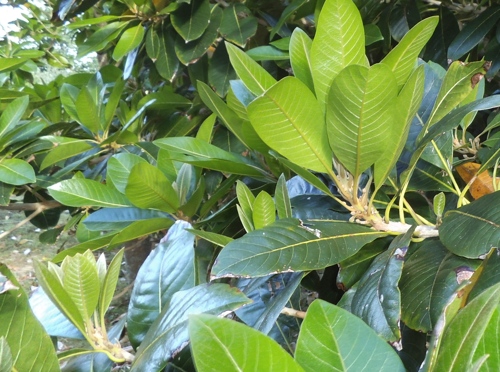 2014 - the trees are flushing
well. The flushes are at different stages of maturity in
different trees. The flower buds on the new flushes are quite
well developed. I tried a few cuttings of the soft new
flushes, but they died pretty quickly. I'll try again when the
flushes are a little more mature.
2014 - the trees are flushing
well. The flushes are at different stages of maturity in
different trees. The flower buds on the new flushes are quite
well developed. I tried a few cuttings of the soft new
flushes, but they died pretty quickly. I'll try again when the
flushes are a little more mature.January 29
Weather
2019 - Sunny and hot, light breeze. High was 31oC in the shade.
January 30
Weather
2012 - Sunny days at last.
2013 - windy, hot, dry. Hasn't rained since late December, and even then it wasn't that much.
2019 - a bit of cloud, hot, slight breeze, 32oC in the shade.
Boysenberries
2012 - The boysenberries have pretty much finished.
Blackberries
2012 - Our few thornless blackberries are just starting. Most years they are a favorite of stink bugs and passionvine hoppers. As a result, the fruit usually have damaged dried up patches on the berries. The thornless blackberries are larger than, but inferior to, the wild blackberry. Most years the wild blackberries around here are pretty scrappy, small, insect damaged, and not very prolific. This year it is different. The fruit are big, fat, juicy, plentiful, and with very little insect damage.
A whanau member mounted an expedition following favorable reports on the remarkable season for the wild berries. The four of us filled 6 ice-cream containers (2 litre) in an hour. The outstanding season is not confined to our backyard.
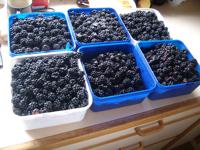
wild blackberries
Plums
2012 - The 'Black Prince' plums are nearly ripe. We finally killed a young female possum by the bush edge, near the plums trees, I hope she is the one who has been eating the peaches and plums. Given a patch of broadleaf native forest adjacent to pasture can support from 10 to 25 possums per hectare, I doubt it was acting alone. A neighbour tells us that when the ARC did a few months intensive trapping in this patch of native forest, they killed 80 possums...
Longan
2012 - One of the 2 longan trees we have had here for nearly quarter of a century (and in a pots for years before that) is finally flowering. I don't expect much, partly because bronze beetles are feasting happily on the tender new inflorescences, and partly because New Zealand isn't really warm enough to mature these fruit. That said, the former Nestlebrae nursery in Helensville did have a seedling longan that set and matured a few fruit - but the fruit were very small, and not much more than a obscurity, really.
Avocado
2012 - The newly set avocados continue to 'size up' steadily. The trees continue to flush, which is a bit unusual.
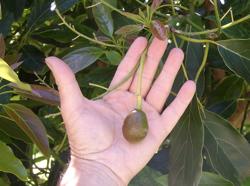
February 01
Weather
2013 - Overcast, warm and windy this morning, by midday there are sunny patches, it is windy and hot. The temperature is 27.5oC. I don't think we had any rain at all here last month.
Peaches
2013 -The heat, wind and total absence of rain have meant peaches have ripened with minimal brown rot - only 3 or 4 fruit. The white peach that the possums hammered last year has given us (and the sheep) some nice fruit. A nice large yellow flesh peach on a small tree is about to ripen. Even eaten slightly firm it is delicious - juicy, sweet, and with good acid. The only drawback (as with all peaches) is the slightly fuzzy skin, although the skin peels off easily. I think the variety might be 'Orion', an older kind, but I am not sure.
For the first time in a long time we have managed to get a few nectarines. The tree is a light cropper, and they usually have a lot of brown rot. These are white fleshed, juicy, sweet, and highly flavored. Utterly delicious.
Plums
2013 - A few elephant heart remain on the tree, and the only question is whether we get them or the birds do.
The Black Prince continue to ripen, and are a sort of strange mottled bronzy-green color. The flesh is deep red, and at the moment firm and crisp, acid, some sweetness, and quite a good flavor. But they have a little way to go, and the acidity is pretty severe.
We had a Louisa plum recently, sort of prune shaped, large, red skin, yellow flesh, clingstone. It was sweet, juicy, soft, and I though very nice indeed.
The last of the Pixie plums have kept in the fridge for weeks. The skin is deepest purple black, there is now almost no acidity, they are moderately sweet and mellow, with smooth, very fine-grained, almost pasty flesh. I really like them, they are very refreshing.
Avocado
2013 - it is very dry, and the big, soft new flushes on the seedlings I planted for grafting onto are wilting. I gave them some precious household water and mulched them heavily with chipped dry bamboo stems. I took a couple of buckets of water from the little dam we have, but it is very low and muddy.
The biggest and oldest Hass tree is starting to color up some fruit on the tree, but none have dropped, which is good. The fruit are small, but it has a fairly good crop.
The small fruiting Reed tree has dropped another fruit. It would have fallen in the morning, and by mid afternoon when I found it, it was blackened and sunburnt on the skin surface facing the sun.
2019 - Many of the Hass avocado fruit are fully colored, and a few fruit drop every day. The new season crop are holding well so far, in spite of the heat. In one area the fruit have 'overset' to a ridiculous degree, and many of these developing new season fruit will likely fall in the ensuing months.
Kiwifruit
2013 - The yellow kiwifruit are full size. What surprises me is that they continue to put up vigorous watershoots, even though the ground under the vines is so dry there are large cracks (I don't water the plants). Where do they get the water from to support growth?
The green kiwifruit also have some watershoots, but nothing like as many as the yellow.
Bananas
2013 - the ground is like dust, and some leaves on the bananas have yellowed. I find bananas to be amazingly drought tolerant plants - which makes no sense at all given their lush tropical foliage.
February 2
Weather
2014 - Hot and dry, only a light breeze. The temperature hit 28oC in the shade, but there is so little humidity it actually feels OK to work in.
2019 - A small but useful shower of rain this morning. By afternoon it was back to clear skies, heat and humidity.
Berries
2014 - still quite a few wineberries, a few boysenberries, and the odd blue berry coming in. The wild blackberries are producing like we have never seen before, and the quality is first rate.
Plums
2014 - we collect the odd bird-pecked Black Prince, and they do actually ripen up in the bowl, and are sweet/acid and good.
Nashi
2014 - the first of the nashis are ripe. This is the small somewhat caramel tasting one, very nice.
February 3
weather
2013 - still hot and dry.
2019 - Hot, no relief in sight.
Hazels
2013 - nuts are now falling, but quite a number look immature. Presumably this is a drought effect.
February 4
weather
2019 - Hot and dry. It was 31oC in the shade.
February 5
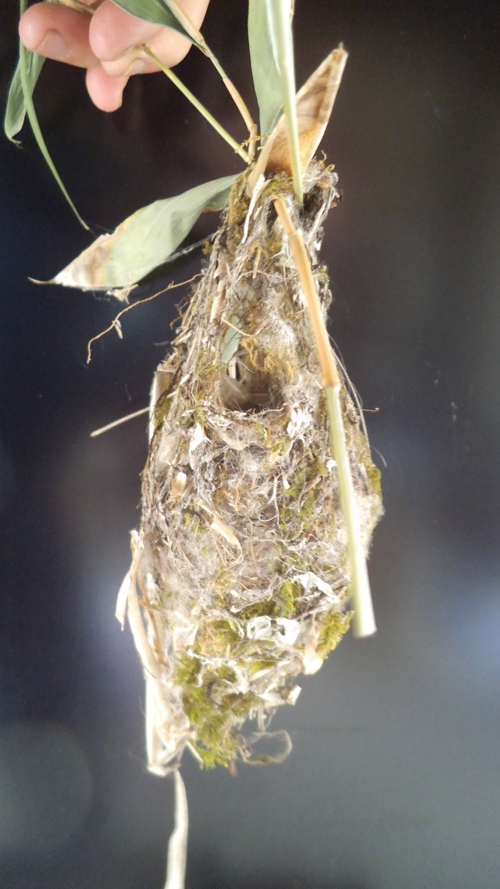 weather
weather2013 - Rain at last, desperately needed.
2014 - Hot and dry, some cloud cover.
Nature
2014 - a shining cuckoo chick is still peeping around the place. There must have been a good crop of shining cuckoos this year - I found 3 grey warbler, Gerygone igata, nests (empty); 2 in the bamboo, low down, about chest height, and another in the very top of an avocado tree.
February 6
weather
2013 - Rain continues, off and on between drizzle. Good amounts have fallen, maybe 50mm or so.
2014 - Totally overcast with an extremely strong easterly blowing all day. A brief rain shower was welcome but the endless wind will have undone any good the shower did.
plums
2014 - A whanau member decided to pick the damson plums to make some damson wine and damson jam. She came back with 15 kgs of fruit. This tree just keeps giving year after year.
avocado
2014 - The very strong winds have only blown off 8 new-season avocados - so far. Not bad considering its strength. Curiously, these are all Hass avos, not one Reed or Pinkerton fruitlet was blown off. To be fair, the fruit were blown off a Hass tree that is relatively exposed to wind.
pears
2014 - the wind has also blown a couple of red Bartlett (aka Bon Chretian) pears off. One has insect damage and is total soft and rotten. The other is not fully ripe the flesh is almost crisp but the flavor and sweetness is 'OK' (while not 'the best'), which is interesting.
February 7
weather
2020 - Hot. You can't be outside in the middle of the day. The grass has all but dried up. We've been cutting and feeding out the bamboo every day, supplemented with sheep pellets.
Stored pond water ran out a week ago. If we are lucky we might get the tail end of a tropical cyclone in the Tasman by late February.
https://twitter.com/NiwaWeather/status/1224939460107784192
February 8
weather
2022 - the last few days finally brought us about 50 mm of rain, after weeks and weeks of dry heat and wind. One day hit 36oC in the shade..luckily, the constant wind took the edge off the heat. The soil is moist to about 30 cms, but bone dry under. Today is totally overcast, with the cloud cover in the morning down to tree top level. Once the cloud limited and watery sun filtered through it became intensely humid, tropical warm and humid, sweaty and enervating.
figs
2022 - first Malta figs are ripe.
Blueberries
2022 - now about over - they have been great, cropping really well in spite of the drought, disease free and plentiful. My partner dried some in the heat. It seems successful.
Peach
2022 - our semi-dwarf peach has had a good crop, partly as a result of the pruning I did last year. It has been so aridly dry and windy over the ripening period that we had had almost zero brown rot - unheard of! Even the guava moth didn't find them. And the possums only found them when they were all but over...and, only a few bird pecked! A memorable year for this variety.
February 11
weather
2014 - initially overcast and a little cool - autumnal feeling, even - it soon turned to clear skies and hot sun. It reached 25oC by midday. I spent quite some time watering some of the avocados and some new tamarillo plants.
2019 - The heat keeps going. Clear skies again, 31.5oC in the shade, thankful for a nice breeze.
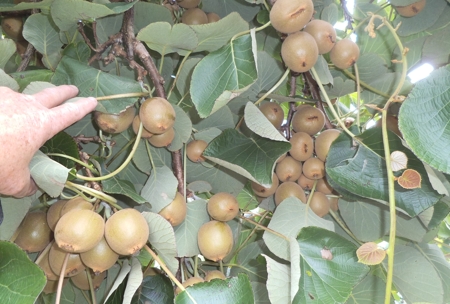 Kiwifruit
Kiwifruit2014 - It has been a challenging season for the kiwifruit. Very dry, a period of extremely strong wind, and with no irrigation. It amazes me how drought tolerant the big kiwifruit are. In spite of the dry, they keep putting up vigorous watershoots, and the foliage remains (mostly) deep green. The crop load on the yellow Sally plant is just stupid. There are almost more fruit than leaves. The stress on the plant must be enormous. But they are planted about 1.5 meters apart, so the roots have some space to forage for water and food. In contrast, the seedlings are crammed up at about 30cm apart in the row, and the competition for resources of moisture and food really stresses them. There is quite some variability in how the seedlings handle this years intense sun, and the water and nutrient stress. Some show marked nutritional deficiencies and some don't; some sunburn readily when I cut back the crowded foliage, some don't.
Peaches
2014 - the late golden queen type seedling is yet to start. It is a pretty mediocre fruit, and the tree is very subject to disease. In contrast, another seedling peach which produces firm-fleshed juicy, sweet, flavorsome small peaches (80-100grams) has been fruiting extremely heavily. It has been so dry this year that we have had zero brown rot in this tree (we don't spray). What we have had is possums. They have been hammering the tree night after night. We have varied the bait in the Timms trap under the the tree, but so far without success. Going by the number of possums spotted on the road at night, the possum population seems to be booming. Time to intensify poisoning and trap set, it seems. These small peaches are really worthwhile- we have had a constant stream of them, many kilos worth, and the queen of the preserves bottles them almost obsessively. She notes that peaches are currently $5 a kilo in the supermarket...
2018 - another huge peach crop, but brown rot is now rampant. We have caught 6 possums under this tree so far, 2 with the Timms trap, 4 with the live trap. The tally for the last fortnight across the property is 8 possums in a fortnight. Quite a surge.
Avocado
2018 - Reed fruit are falling. There are still quite a number of Pinkerton hanging on the tree. They also fall from time to time. The seed in some of these Pinkerton fruit is germinating.
Sheep
2014 - the sheep are doing well, in spite of the drought. Their condition has been assisted by my laziness. I had left a space in the fence around a few small avocado trees I had planted under some eucalyptus trees. The idea was that a gate might usefully be hung there at some future point. In the meantime a sheet of old corrugated iron closed the gap. It has got a bit rusty around the edges with the passing of the years, and the recent wind rattling it did the rest, The sheep had a marvelous time eating the young (and struggling!) avocado trees, the lank dry grass, seedling coprosmas, and anything else in reach. No wonder they were lounging around like stranded whales this morning!
February 12
weather
2014 - At last, 3 or 4 millimetres of showery rain fell for a short time this morning. Apart from one brief shower on the 6th, it has been dry, and either sunny or windy ever since the rain-burst on january 26th. This little bit of moisture will keep the kikuyu green, but that's about it.
2019 - Hot. 31oC in the shade.
nature
2014 - The baby Californian quail are now quite well fledged, and if we have a 'surprise meeting' they fly up with a whirr of wings. They look like a small flock of sparrows taking flight. A big, wild-looking cat has been seen stealthing around the place recently. I hope it doesn't kill too many of these delightful little quail. Maybe it will go for the abundant rainbow skinks, much easier prey. Their baby-pea sized white eggs turn up buried in t he soil, and the babies are hatching out right now.
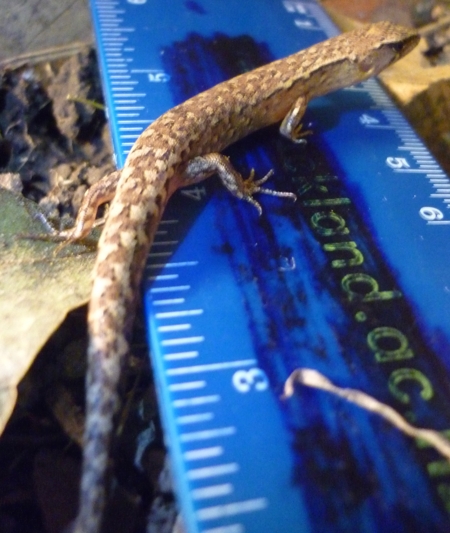 Several times in the
last 25 years we have come across an unusual very 'chunky'
robust skink. One was brought in by the cat many years ago,
another was briefly captured by the kids and let go after
marveling at its unusual size. Recently we came across another
one, but it escaped into the debris around the house before we
had a chance to examine it. These unusual skinks have all been
found around the shaded and cool side of the house, where
there is leaf litter, and a retaining wall with very large
grade scoria creating lots of lizard-sized spaces.
Interestingly, I have never ever seen a rainbow skink in this
area. This is a nice cool environment, and the rainbow skinks
seem to be found in sunny places.
Several times in the
last 25 years we have come across an unusual very 'chunky'
robust skink. One was brought in by the cat many years ago,
another was briefly captured by the kids and let go after
marveling at its unusual size. Recently we came across another
one, but it escaped into the debris around the house before we
had a chance to examine it. These unusual skinks have all been
found around the shaded and cool side of the house, where
there is leaf litter, and a retaining wall with very large
grade scoria creating lots of lizard-sized spaces.
Interestingly, I have never ever seen a rainbow skink in this
area. This is a nice cool environment, and the rainbow skinks
seem to be found in sunny places.This area is a cobwebby narrow space, and the whanau have grown up, so no longer play there. But some of their plastic toys and other residues of childhood remain. So one of the now adult whanau members started removing the artifacts of childhood, and removing the dead tangles of the Akebia (Akebia quinata) vine that I sprayed out some years ago. He disturbed a skink, which ran up under the hardiplank wall cladding, but didn't quite make sanctuary before it was captured.
This skink is similar to the other unusual lizards we have seen previously, but is much more conventionally slimly skink-shaped. It's head shape, color pattern and orange eye with a white 'tear-drop' under it suggests it might be the shore skink, Oligosoma smithi. According to Landcare, this lizard is found in the upper North Island, with distinct west coast and east coast populations. Apparently it will dive in rock pools, so it is sometimes known as the diving skink. It also eats coprosma berries, and climbs kawakawa plants to eat the fruit when they are ripe. Insects are likely to form the main part of its diet, though.
I sent some photos through to the New Zealand Herpetological Society, and they replied that it is actually a young ornate skink (Oligosoma ornata). Apparently the golden ornate pattern on the tail and the white 'teardrop' under the eye are diagnostic of this species. Apparently it is a threatened species, and for this reason we are quite lucky having this species on the property. The Department of Conservation threat classification from 2010 is "Very large population and low to high ongoing or predicted decline. Qualifiers: Conservation Dependent, Partial Decline". So I guess the upshot is that there is a reasonable population, but it is declining, and the rate of decline depends on measures to conserve habitat, and get rid of pests such as rats, mice, hedgehogs. And control wild cats. (Not much you can do about pet cats.)
sheep
2014 - Bamboo has really greened up, and has lots of succulent branch tips. It has to be cut, or it will get away on me. A bonus for the sheep, which love the tender new shoots. They are also getting windfall apples and possum munged peaches, as well as the usual trimmings of invading mahoe and coprosma.
Geese
2014 -The geese have been in the 'new' little avocado patch where I intend to play around with size-control single leader pruning of interesting varieties. The grass has been allowed to grow and seed, and the kikuyu has also ramped up. Some areas of grass are moderately well controlled by the geese, but it is a grassy field, not a lawn, that is clear! The geese spend a lot of time lounging in the shade, and have started their moult, so they are not much use as lawnmowers right now. So I have put them back in our tiny dam area.
February 13
weather
2019 - Hot. 31o C in the shade again.
February 14
weather
2020 - The drought grinds on. 32.5o C in the shade!
Livestock
2020 - Sheep - Kikuyu is about gone. Most of the grass is all but gone. Bamboo and tree trimmings - loquat, mulberry, plum, Asian pear, coprosma, mahoe - keep them in good condition. And, starting now, windfall fruit.
February 15
weather
2020 - Today the weather records for Auckland have been smashed. It is now the longest period of dry weather since at least 1943 (when records began).
February 17
weather
2013 - The rain we had earlier in the month is it. Not a drop has fallen since. It is very dry. The maximum temperature was 34oC earlier in the week. Today it is a moderate 26oC. Recent overnight lows have been around 15oC.
Livestock
2013 - Sheep - Kikuyu is just hanging on. Bamboo and tree trimmings - loquat, mulberry, plum, coprosma - keep them in good condition. Plus windfall fruit.
2013 - Geese - I am experimenting with a pair of Chinese geese for grass control between small low-to-the-ground avocado trees. It has been moderately successful so far, but today I found the female dead. She had moulted and been 'off the lay' for months now, but when I found her it was clear that she was 'egg bound'. This is completely the wrong time of year to form eggs, so I don't know why this happened. The main symptom of egg binding is not eating and listless laying about. It has been so hot, that is pretty much what the geese do in the day anyway - rest in the shade.
February 18
weather
2014 - Hot and very dry. The temperature at 2:15 in the afternoon was just over 29oC. Cicadas are deafening - literally - near some of the groups of trees on and around the property. They are in full song even at 3:30 in the morning, when it is completely dark. In fact, they sing right through the night. Where do they get their energy?! Click beetles and baby crickets have appeared.
Passionfruit
2014 - now falling.
Figs
2014 - the first Maltas are ripe
Feijoas
2014 - a solitary small fruit was found on the ground. It appears to be ripe.
Peaches
2014 - our prolific small peach is over, and the first of the Golden Queen type self sown fruit have coloured and been chewed and knocked off the tree by possums.
Avocado
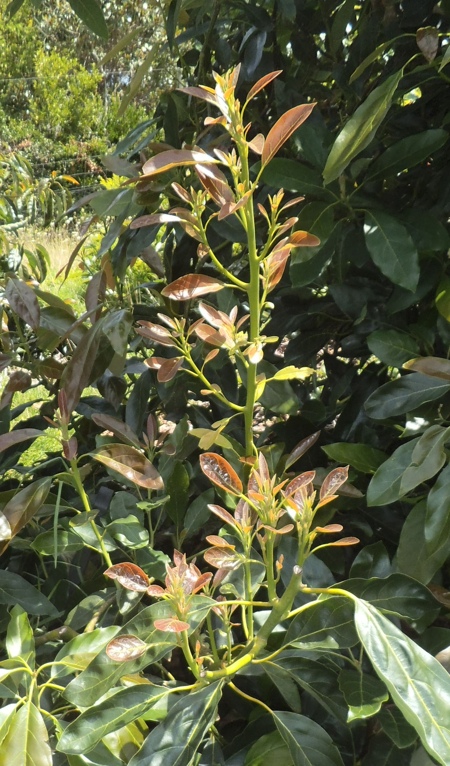 2014
- the experimental size-controlled Hass trees were putting out
too much new growth at the very top of the tree, where I can't
easily get to it . So I chainsawed the top out of both trees.
All the avocados have matured their main spring flush fully,
and are having a modest summer flush - a bit surprising,
considering the dry. Some trees - notably the size controlled
Hass - have put out very strong and vigorous 'watershoots'.
The South Africans call these 'bull shoots', which could be a
bit confusing if you say it fast....Anyway, they are not the
sort of growth I want, so I prune them right out. The lower
watershoot had already been cut back once previously. It has
responded by putting out numerous small shoots. These shoots
can be useful if you are trying to 'fill in' an area of the
tree that has been cut back heavily, but if not, they have to
go. The 'normal' growth flush can be seen in the lower left of
the photo. The leaves are full size, and are still a bit
bronzy colour. They will soon be deep green. They have an
active growing tip, but won't put on significant extension
growth (unless we have torrential warm rain...)
2014
- the experimental size-controlled Hass trees were putting out
too much new growth at the very top of the tree, where I can't
easily get to it . So I chainsawed the top out of both trees.
All the avocados have matured their main spring flush fully,
and are having a modest summer flush - a bit surprising,
considering the dry. Some trees - notably the size controlled
Hass - have put out very strong and vigorous 'watershoots'.
The South Africans call these 'bull shoots', which could be a
bit confusing if you say it fast....Anyway, they are not the
sort of growth I want, so I prune them right out. The lower
watershoot had already been cut back once previously. It has
responded by putting out numerous small shoots. These shoots
can be useful if you are trying to 'fill in' an area of the
tree that has been cut back heavily, but if not, they have to
go. The 'normal' growth flush can be seen in the lower left of
the photo. The leaves are full size, and are still a bit
bronzy colour. They will soon be deep green. They have an
active growing tip, but won't put on significant extension
growth (unless we have torrential warm rain...)One little Hashimoto tree had a couple of fruit set, which I thought was pretty good, given how young the trees are. However, I found them on the ground today, black and dead. when I cut one open, I found the seed had not formed properly, so it looks like it had not been properly pollinated.
The smattering of current season Reed fruit have become noticeably dull and almost 'dusty' looking, with perhaps a very faint dark undertone to the skin. They are perfectly mature right now. In fact, some have softened on the tree.
Berries
2014 - Some blackberries are still being picked. They are not as flavorsome as the wild ones, but some of them are pretty good. I'm suprised they are still producing, given the dry.
February 19th
weather
2019 - Sunny and hot, still most of the day, then a welcome light breeze. A high of 35oC in the shade. It is now very dry, the ground is cracked.
February 20th
weather
2019 - The forecast was for 27oC today, but the morning started windy and overcast. Heat built up under the cloud cover, and the humidity was intolerable on this coast (the east coast was much less humid). Temperatures hit 31oC . There is no rain forecast for at least the next 7 days. Some plants will be looking a bit grim by then. I have been siphoning water from the little dam from time to time for strategic watering - a very time consuming activity.
February 21st
weather
2019 - The high for today was 28oC, and if not for the nice strong breeze, it would be stinking hot again.
Apple
2014 - The apple variety 'Lobo' is pickable. Not at its best, but certainly acceptable.
Hazel nuts
2014 - I picked up a decent handful of nuts from 5 'trees'. The other 20 odd trees produced nothing (or nothing worthwhile). A whanau member had picked up 3 times this amount 4 or 5 days ago. Quite a number are still in the green husk, and are whitsh and immature. Whether wind has blown them off or drought has caused them to jump early, I don't know. Rats are eating the nuts - the first time they have ever been attacked. Guess we were just lucky up 'til now.
February 22nd
weather
2014 - overcast at first, brief humid drizzle. Enough to ramp up the brown rot, but that's about it.
2019 - hot and humid, overcast, 32oC in the shade. Waiting for rain to break the drought, hopefully overnight.
Figs
2019 - Our Petrovicha fig has had a small crop of 'intermediate season' fruit. These are slightly distorted, sometimes slightly 'turbanned'. The breba crop of very large fruit is always very small, the main crop more numerous bit the fruit are 'average' size. We have never ever had another crop in between these two before.
February 23th
weather
2014 - A clear, sunny, hot day. The high was reached 30oC.
peaches
2014 - we have a seedling that produces large, slightly beaked, dense fleshed very mediocre tasting fruit. It has quite agood crop every year, but it is very disease prone. This year is no exception. Brown rot affects almost every fruit. I found only 6 unaffected fruit. The most productive use for this tree will be as firewood, I think.
February 24th
weather
2014 - Another clear, sunny day. The high was only 24oC, due, I guess, to the very breezy cool southwesterly. The temperature at night has really fallen.
persimmon
2014 - I notice the earliest persimmon fruit (Nishimurawase) is starting to color up.
peaches
2014 - our other 'good' small firm peach is now dropping fruit everywhere. It has a bit of brown rot after the recent humid day, but not too bad.
feijoas
2014 - suddenly 4 or so trees have started to drop fruit. They are pretty small, but that is hardly surprising, given the drought. Unfortunately, we now have to run the sheep in the area, as grazing is at problematically low levels, so they scoff them before we ever see them.
lucuma
2014 - most of the lucuma trees are now flowering, or in flower bud. Last years fruit set are sizing up nicely, but apart from one tree, the set is very poor.
avocado
2014 - our poor little stunted Reed avocado tree is really suffering in the dry, especially as a row of feijoas is hard up against it and it is too far uphill to gravity feed water to. It dropped 4 fruit today, all of them soft, tree ripened, in fact. All had some sunburn, but the flesh was perfectly ripe, deepest yellow with a lime green halo, peeled perfectly, and no rot under the blackened sunburnt portion. As a whanau member observed, when you cut a Reed, you almost always have a perfect attractive flesh, with none of the rots or flesh discoloration you get in Hass. "How often do you see that in a supermarket Hass?", he asked rhetorically. "Sometimes, but not that often", I replied. "Damn right", he said. He has a point. Reed also peels supremely easy, another plus. It does sometimes have a tiny amount of rot at the point where the stem attached (if it detaches naturally and falls from the tree, rather than being picked), but it is trivial.
February 25th
weather
2013 - It has been almost 3 weeks without rain. The weather is sunny, hot, and generally calm. Sometimes a gentle sea breeze blows. Today it is 27oC at 1.30 pm. Over the last few days it has hit 31oC. Water is a big issue. There is a little water in our tiny fire dam, and I am planning to siphon what is there out onto important trees, then mulch them. When the water runs dry, well then, we will see who survives the drought.
Berryfruit
2013 -The blueberries are pretty pathetic due to lack of water. They have to be hand watered, but we can spare only enough to just keep them alive.The blackberries are producing quite well and seem relatively unaffected by the dry. They don't get water. The raspberries are still producing some fruit, but the leaves are starting to curl, and some berries are now small.
Kiwifruit
2013 - The yellows and greens still look very good. Some seedling plants near a feijoa hedge are now developing brown, curled leaves. I am amazed the kiwifruit have shown only minimal damage so far. They get no water.
Bananas
2013 - The banana plants are doing relatively well, in spite of the drought. I would have thought they would be like a limp rag by now. Leaves are certainly yellowing off, but by and large they are in good shape. There are now numerous bunches of bananas formed, some quite recent. It looks like there will be an extended ripening from autumn into winter.
Figs
2013 - the main crop haven't really started yet. There are a few Malta fruit near ready, and the figologist is picking them early to thwart the birds.
Plums
2013 - Damson plums are now acceptable. As sheep and kaka ravaged our Black Prince plums, that is all we have left.
Peaches
2013 - As one self-sown peach seedling ends, another starts. Unfortunately kaka seem to have discovered how good peaches are too. I expect the worst.
Avocado
2013 - bigger trees are dropping leaves, but still look mostly OK. The Hass fruit have held on very well, but there is a recent uptick in commencement of ripening on the tree.
Stock
2013 - Sheep - looking good, and the mating season is coming up. Feed is pretty much bamboo, kikuyu and mahoe. We are fortunate that I haven't tidied up self-sown invasive natives for years now.
2013 - Geese - a Pilgrim goose female has been found for the gander. He accepted her as if she had been there all her life. Suprising.
Feb 27
weather
2012 - Odd month. Not as much sun as usual, some good rain, its been grey and showery quite often. Today the cicadas are going like crazy, but there are lots of black crickets about. It feels a bit like autumn.
2013 - Dry.
2014 - The mornings are now cool, but the days are hot. It was 29oC yesterday. At least it was cloudy this afternoon. The place is dry, and I am feeding lush green bamboo from the shelterbelt to supplement the sheep's diet. That and proably half a bucket of windfall and damaged peaches every day.
Berryfruit
2012 -The blueberries are nearly over, the blackberries are just past the peak.
Nashi
2012 - The first nashi fruit are now ready, according to the birds. We have had to start picking them, even although they should be left a bit longer to sweeten up.
2014 - the nashi are very small indeed, due primarily to the drought. The birds find them an excellent source of moisture, and the the wasps then move in on the sweet juice...
Apple
2012 - The odd apple variety 'Lobo' has fallen, reminding us this apple is ready in mid-late february. This is an early apple with a crisp 'bite', sprightly, moderately sweet, and not bad for the first apple of the season. They will be sweeter a little later, but there is a fine line between they are at their best and when the flesh starts to become 'floury'.
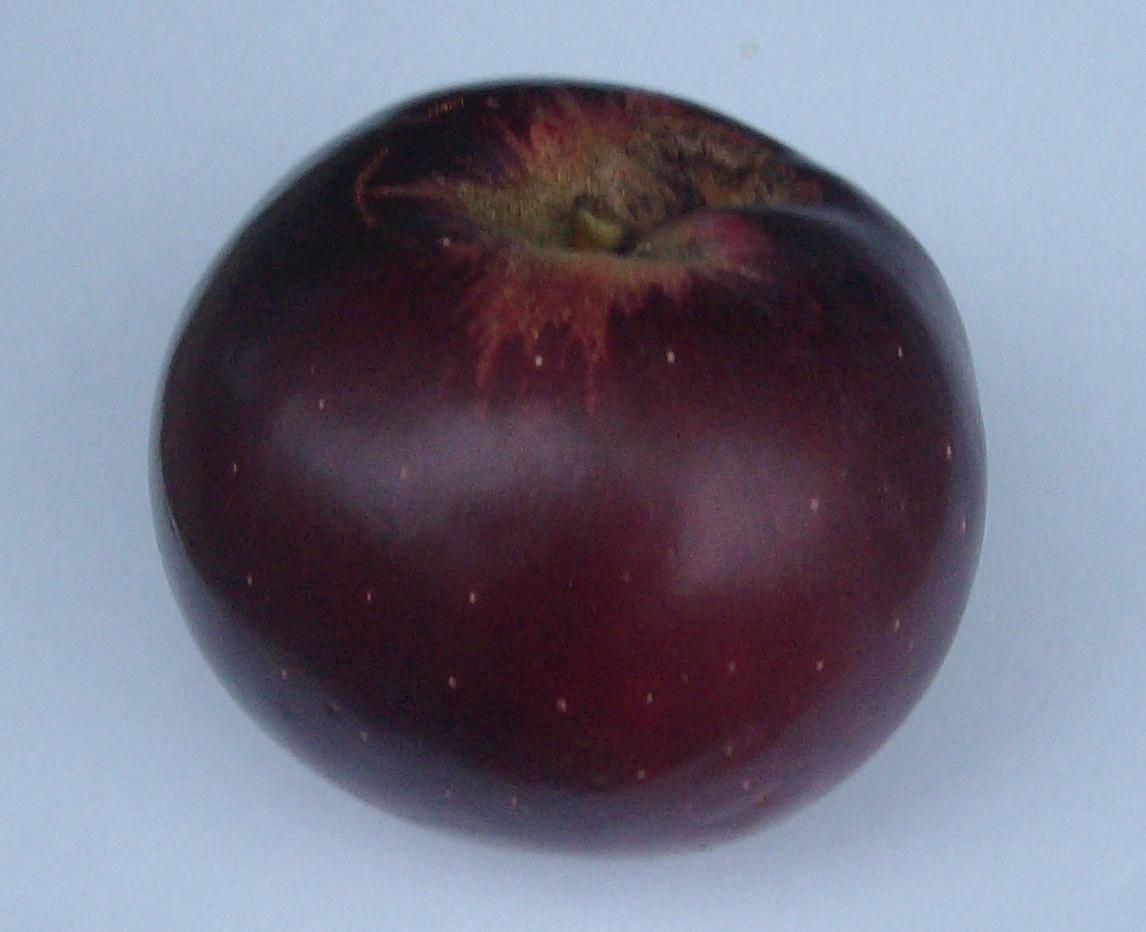
Apple Lobo. The natural skin 'bloom' can be rubbed off to take
on a very shiny, almost varnished-looking polish.
Avocado
2012 - The avocados simply haven't stopped flushing, and the new fruit are sizing up very well. The first Reed fruit has fallen, and the remaining Hass on our oldest tree are showing some signs of skin colour change.
2013 - What a difference water makes. Our youngest Reed tree has been watered from time to time from water siphoned from out little dam. The 'old' tree can't be watered from the siphon because it is higher up the hill, and the siphon no longer works at that level. The old tree has had a few buckets of water thrown under it, but given the extreme dry, plus the feijoa hedge planted hard up against it, and the water has not done much other than keep the tree alive. As a result, the fruit on the old tree are about golf ball size, whereas the fruit on the young tree are at least double that.
I continue to be surprised at how well the fruit on the Hass avocado trees is holding on. Leaves continue to drop. One severely pruned avocado has some flowering branches - well and truly out of season! It will be interesting to see if anything sets...
A huge, vigorous avocado seedling that for many years has flowered well without setting anything has set 6 fruit for the first time ever. Few seedlings ever produce fruit, even if they flower well, and of those that do, most are unproductive, or poor quality, or the seed is too big, or the fruit is too small, or some combination of these. I'm not expecting much.
2014 - the small Reed tree continues to drop fruit. Some fruit are withering on the tree. They fall at a touch. Quite a number of the new season small fruit are turning black. Some have fallen off already. This tree is really suffering in the dry. In the end I brought it several buckets of precious tank water. The bigger tree can be watered with water siphoned from the dam, and it gets a little water about once a week. It seems to make all the difference. The last few fruit of this seasons crop are holding well and are a fairly good size. The young new season fruit are hanging on the tree and looking good. The only Hass avocado with a current season crop is heavily stressed by the drought. Its leaves are light green, and some are yellowing and starting to fall. It still has a good number of fruit on the tree, and most have turned partially black. The surprising thing is that it has not dropped a single fruit.
Hazelnut
2012 - A couple of the hazels have dropped (literally) a few nuts. Only 3 or 4 of the hazel trees here ever have more than a handful of nuts at best, but this year there is almost nothing. Hazels are a summer nut, unlike most of the others, which are autumn and winter. (I never understood the nursery rhyme "here we go gathering nuts in may on a cold and frosty morning" because the equivalent of may in the Southern hemisphere is November, and nuts aren't ready in spring. Apparently the modern version is a corruption of "here we go gathering knots of may on a cold and frosty morning". A 'knot', in this context is a bunch of flowers. 'May' are the flowers of mayflower, Crataegus sp. And mayflowers are the earliest of the deciduous trees in the UK to start flowering after winter.)
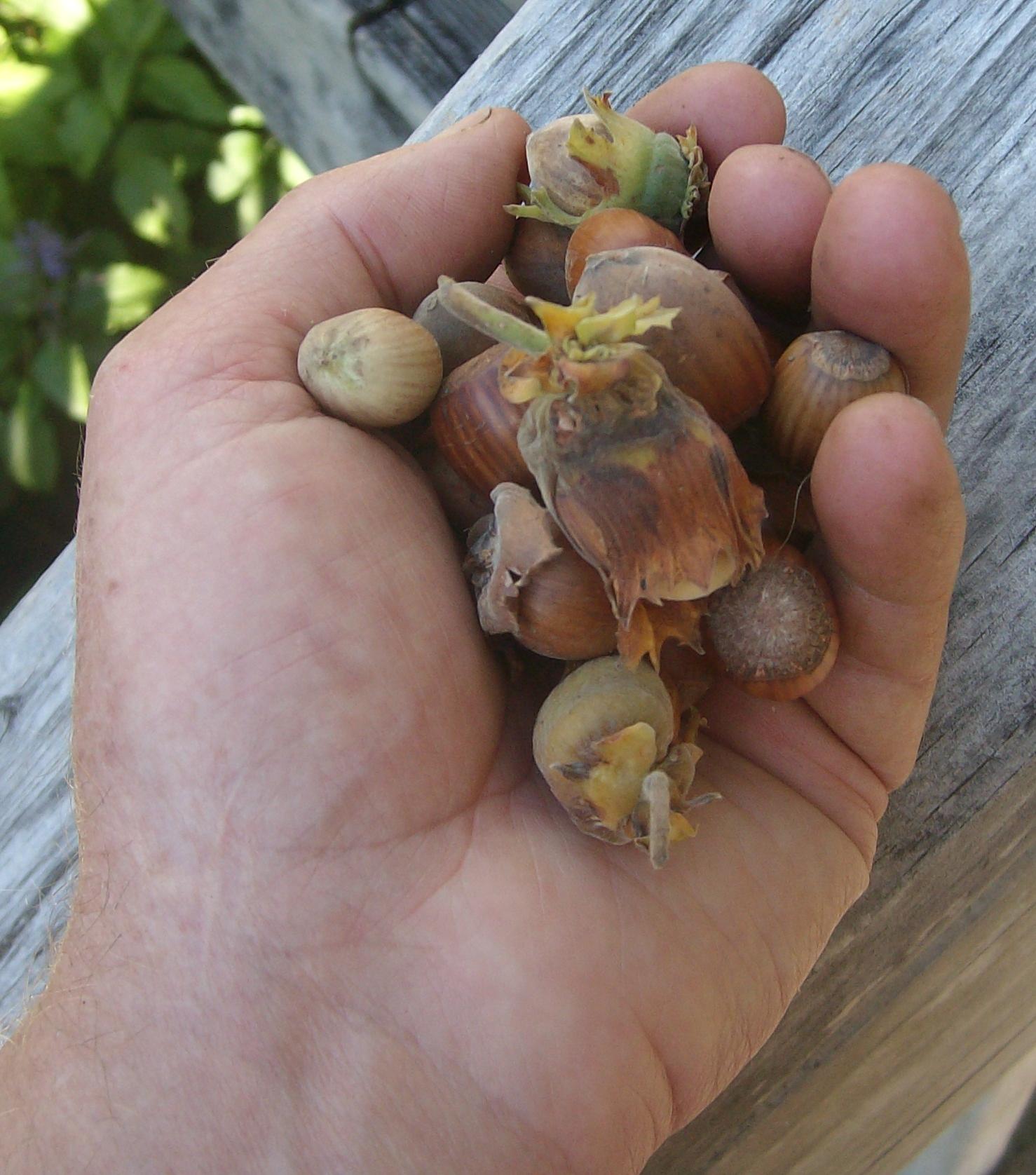
Hazels drop in late February in Helensville
Pecan
2012 - Same story with the pecan trees. They are growing as well as normal, but this year there is not a nut in sight.
Macadamia
2012 - Most of the macadamias have a good crop, and the rats have started on them with a vengeance. Time to do the autumn rat-poisoning run.
Kiwifruit
2014 - The small Actinidia arguta fruit are now mature. The odd one has fallen over the last few days, ripened naturally on the vine. They are very nice. Usually they get covered in sooty mold, as passionvine hoppers love them, and the black mold grows on the sugary honeydew the hoppers excrete. But there are very few passionvine hoppers on them this year. Don't know why.